Best cycling base layers: The starting point for on bike comfort
The best cycling base layers are an essential foundation for optimal temperate regulation
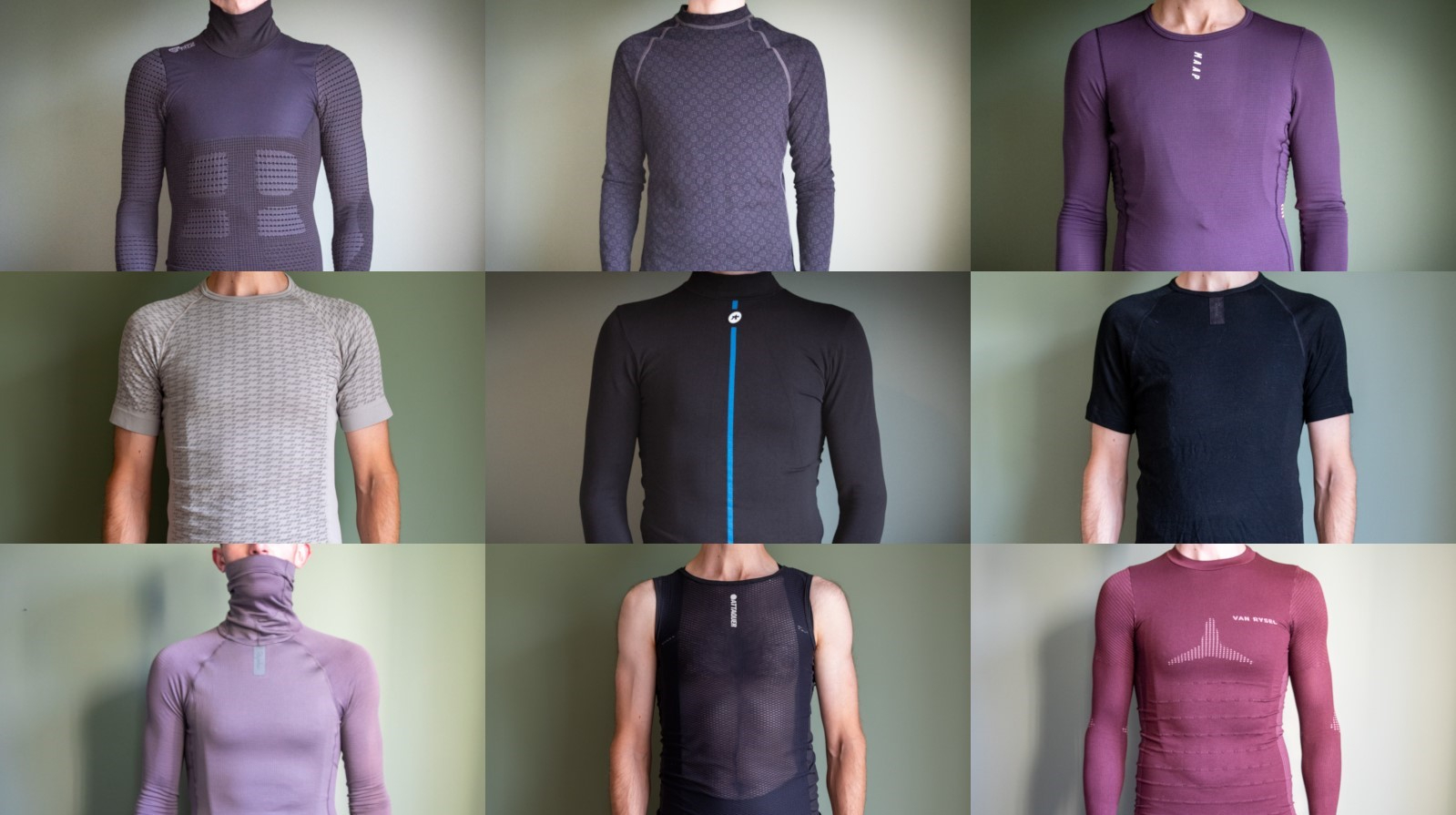
The best cycling base layers can help keep us warm and comfortable on the bike in winter. In warmer summer weather they can also help keep us dry and deal with moisture.
When worn under one of the best cycling jerseys or the best winter cycling jackets, a base layer creates warmth and keeps the wearer comfortable across a range of temperatures.
I always ride with a base layer. I find it more comfortable in summer and love the feeling of a soft, warm base layer in winter. This guide is split into winter and summer options, with winter coming first and being our focus now we are deep into winter in the northern hemisphere.
If you want the heaviest-duty winter base layer then check out the Spatz Basez Extreme option. If you are looking for a good value, more affordable option then the Van Rysel Racing base layer is my top pick. For the best overall, The Assos LS Winter skin layer is a beautiful, highly effective base layer, but it does come at a price.
This guide focuses on men's and unisex base layers, but we have a separate guide for the best women's cycling base layers too. You can also head to the how to choose section at the bottom of the guide to read all of my base-layer buying advice.

I've been cycling in base layers for over twenty years and testing them for Cyclingnews for two years solid. Whether it's summer or winter I always have a base layer on. I've tested over 25 winter base layers alone in testing for this guide.
I've tested all the base layers here over extended periods of time and in a range of weather conditions and temperatures and at different riding intensities. I consider that we will all want slightly different things from our cycling kit so have done my best to include a wide selection of base layers that should suit most people.
This guide was last updated on November 26th, 2024.
We checked all the products that were still current, removed two that had ceased production and added links to reviews of two newer ones. We've also subbed in a new Rapha summer merino base layer. We've switched the focus from winter to summer base layers, incorporated buying advice from a major manufacturer and anointed a new best overall. Finally, we added an author bio to provide a little more information on our testers and how they test.
Best cycling base layers: Quick list
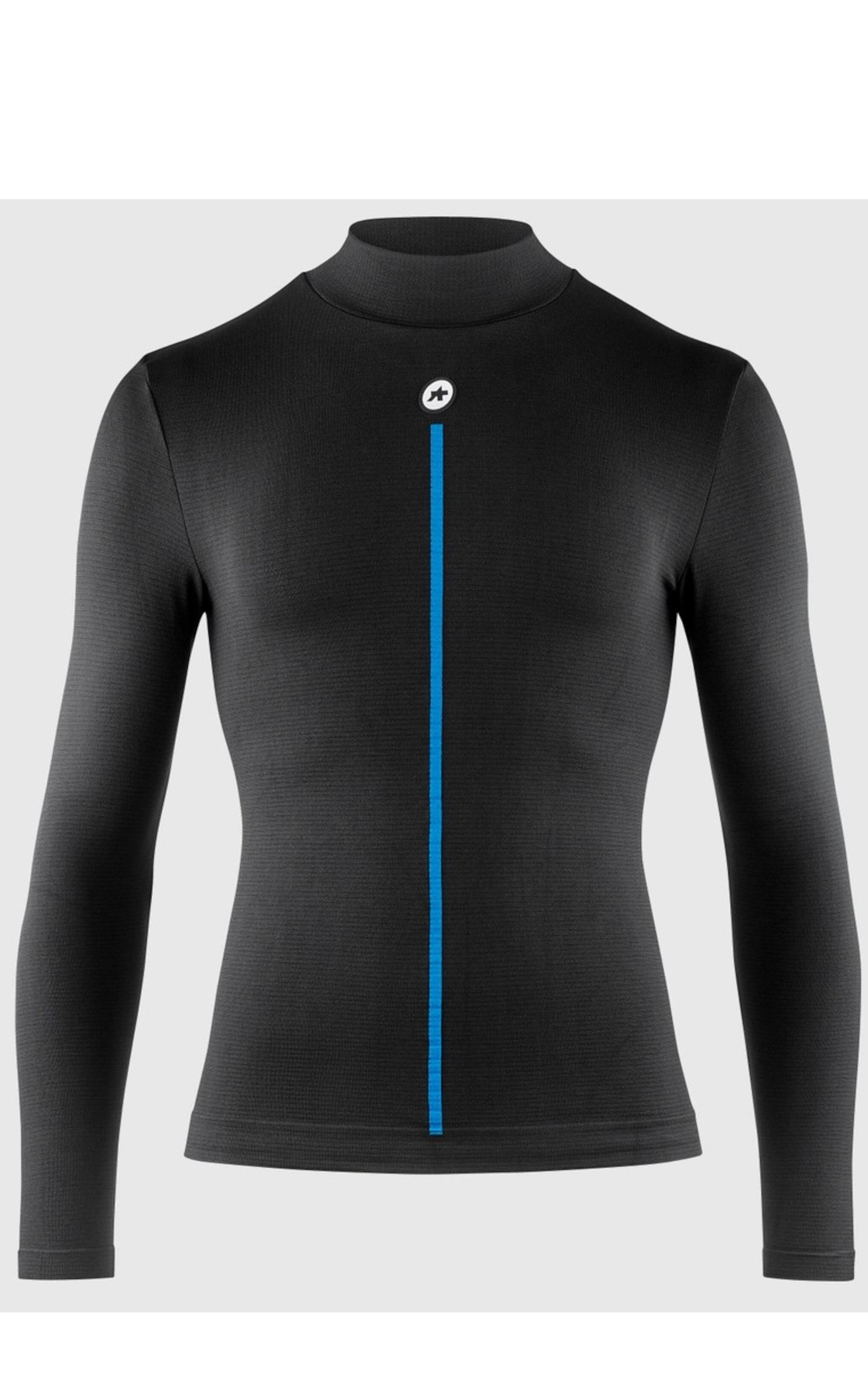
The Assos LS Skin layer is incredibly comfortable, well-fitting and warm. I reach for it time and time again during the cold months.
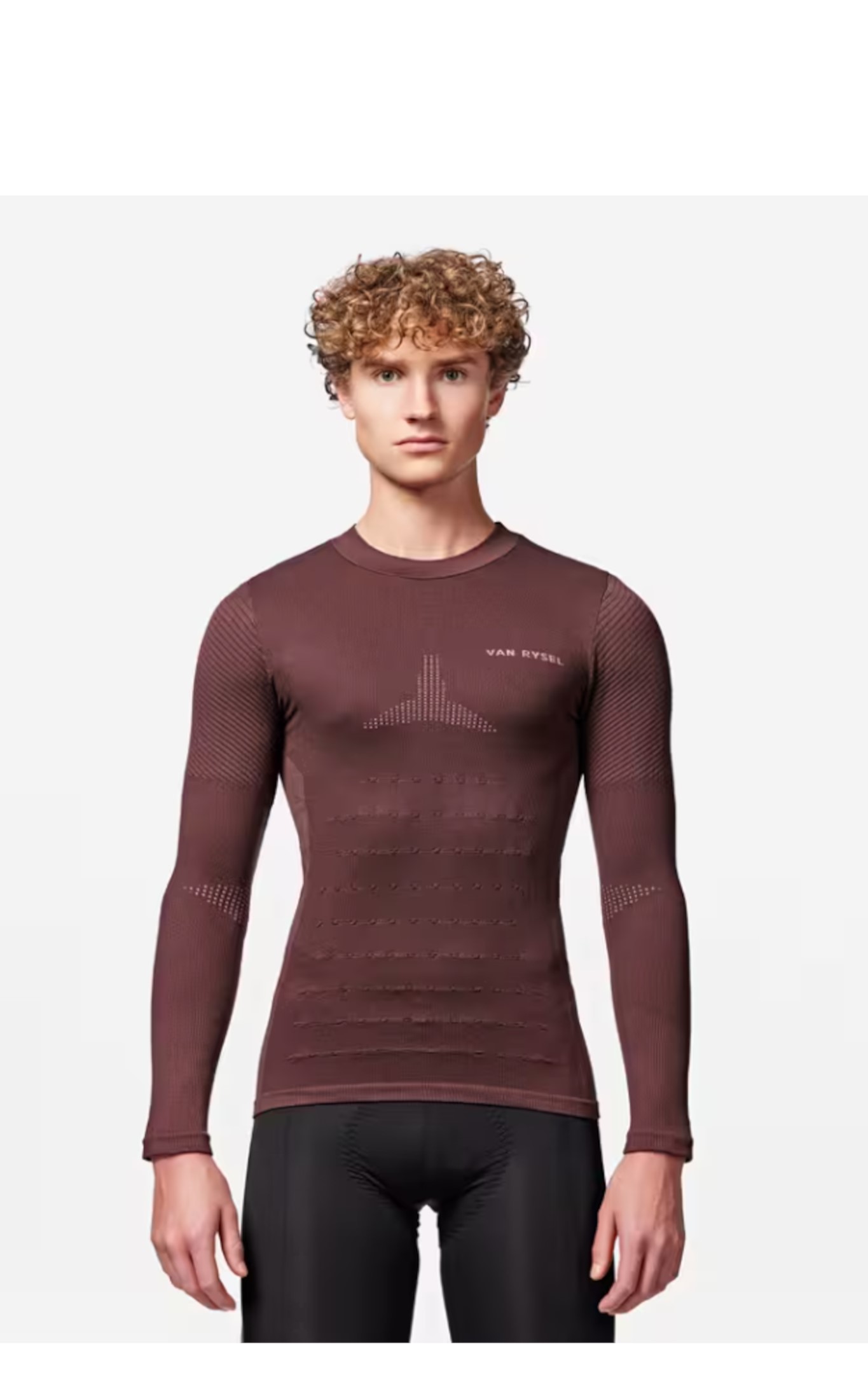
The Van Rysel Racer 2 base layer offers fantastic performance for its affordable price and punches well above its weight.

The Merino Xtreme from Thermowave is a very comfortable Merino wool blend option. It's my best all-rounder and will work for cycling, hiking, and relaxing post-ride.

The Attaquer Summer base layer takes my top summer spot. I've worn it for over 13 hours straight on a ride. It's light, very comfortable, and super breathable.
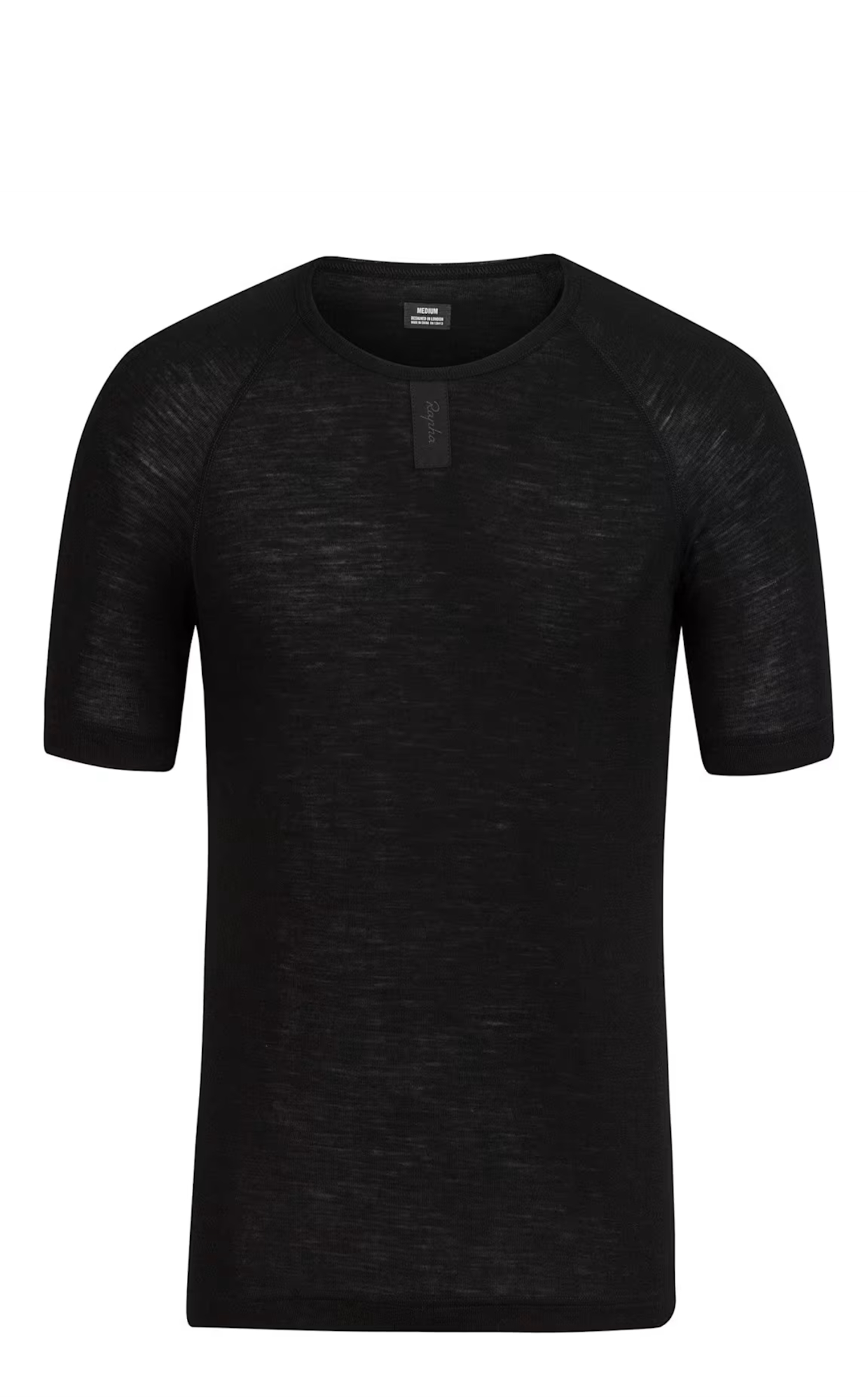
The Rapha Merino Short Sleeve base layer is 100% merino wool. It's wonderfully soft and comfy and will keep you feeling fresh and dry.
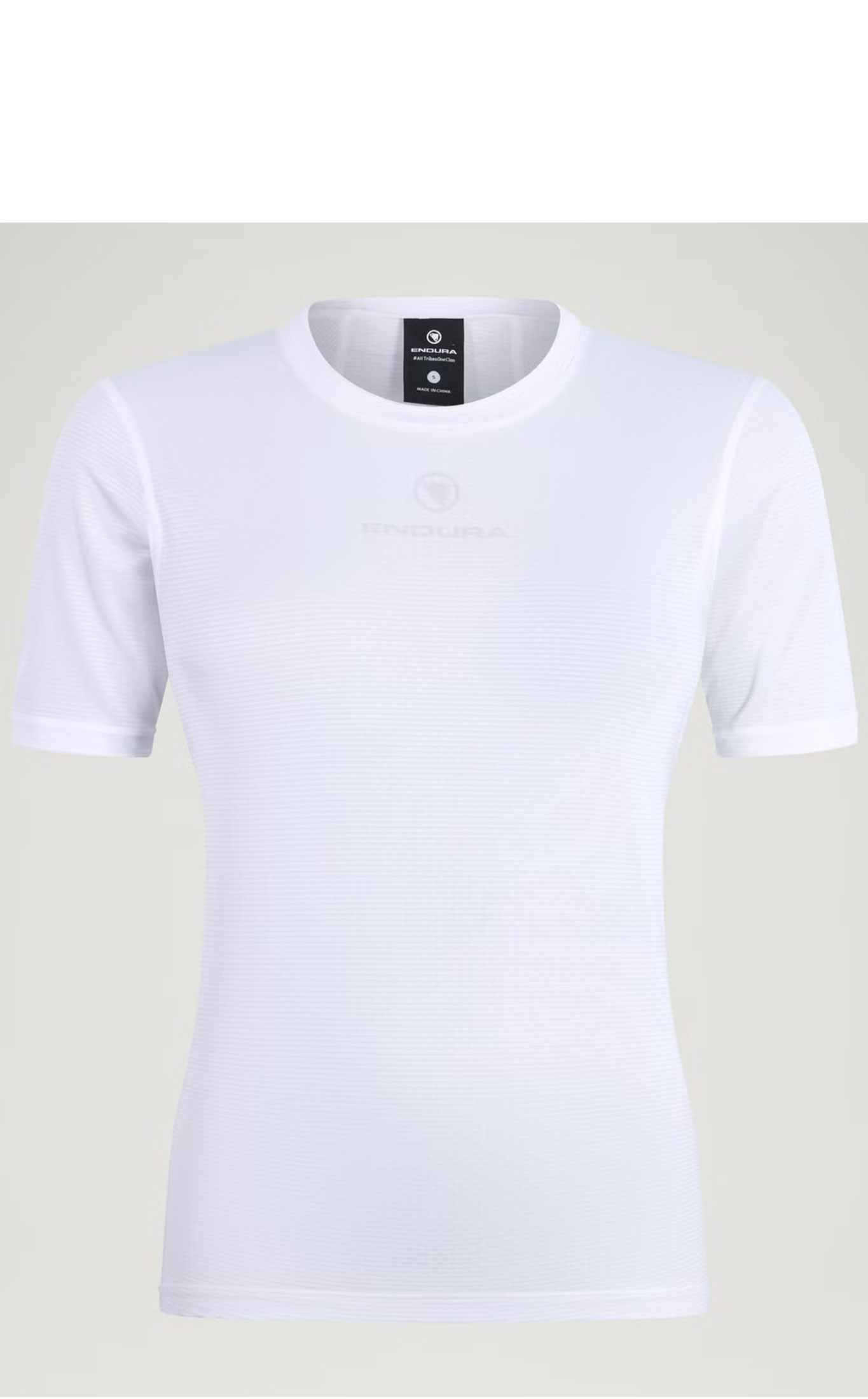
The Endura Translite II is a really soft and breathable summer value option. It will do a great job on the bike and won't break the bank.
Winter base layers
A winter base layer is about retaining heat and keeping you comfy. It will be thicker than a summer base layer and will usually have long arms to help keep in warmth. It still needs to wick sweat away effectively though to avoid cold, damp spots.
Best Overall - Winter
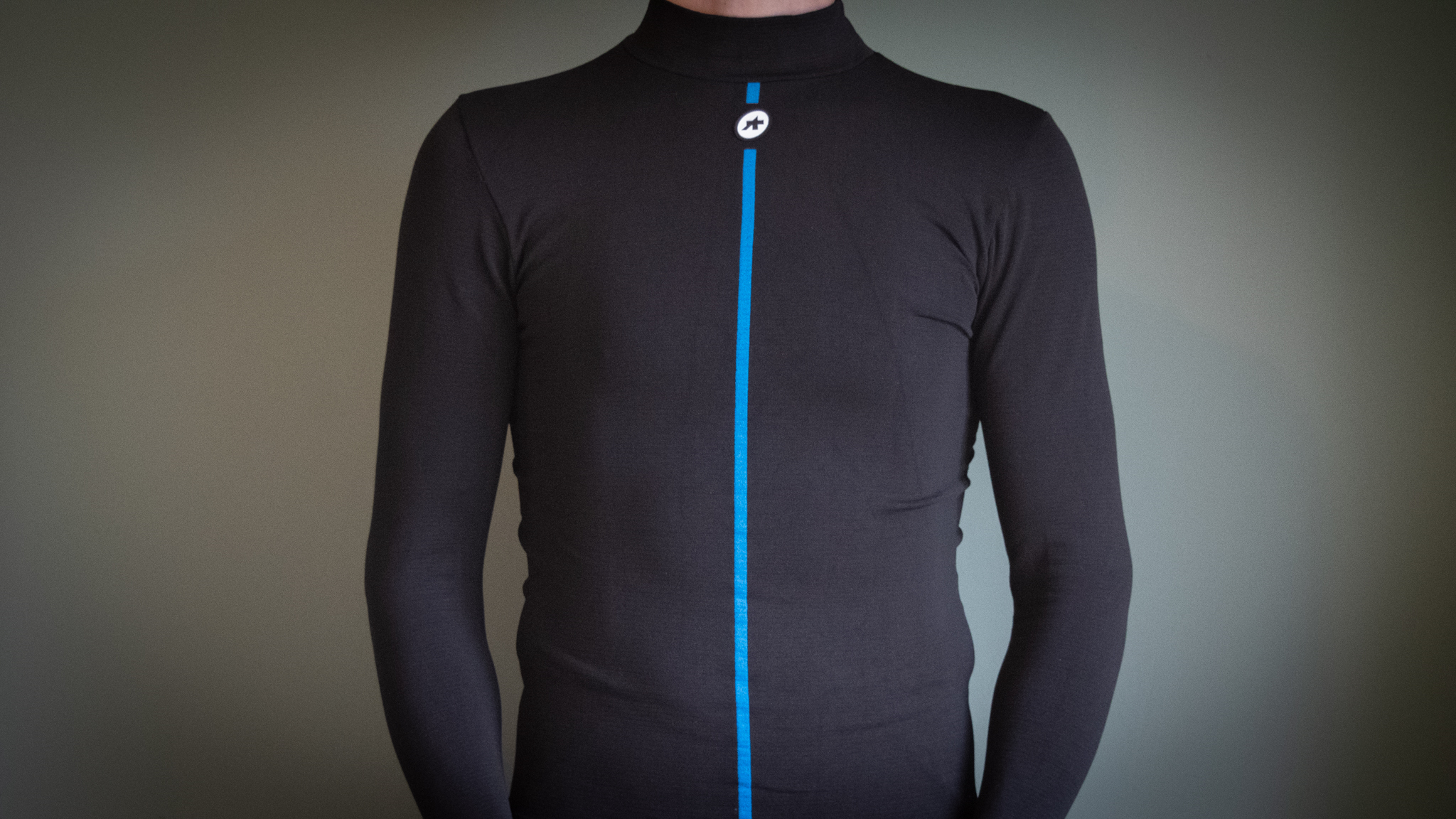
Specifications
Reasons to buy
Reasons to avoid
✅ You really value comfort and warmth: I reach for this base layer a lot in winter. It's super comfortable and always keeps me warm
✅ You want to treat yourself: It's a premium piece, and the price tag is heavy, but there's just something about it. Pulling it on feels magic.
❌ You don't want to spend too much on a base layer: Differences are finer with base layers and far more affordable options will keep you warm and snug.
Like a lot of Assos cycling kit, there is something special feeling about the LS skin layer, and it takes my best overall winter spot.
Its fit and feel are the best of any of the base layers in the guide. Construction is mostly from a mix of carbon and polypropylene yarns with some elastane, which is meant to draw moisture away from the skin. The material is a little thicker than everything here bar the Spatz and GripGrab offerings, but it's definitely the softest feeling when you're wearing it, is stretchy and does feel like something of a second skin. The base layer has also received an update this winter, the updated piece is almost identical but the back is now slightly more breathable to help regulate temperature.
The skin layer has a raised neck that is well-shaped and fitted to help keep you warm. Make sure you pay attention and double-check your size against the Assos sizing when buying. I'm a size small in pretty much everything but this test product is an Assos M.
The Winter Skin layer is a high-end base layer that will keep you warm and snug during the winter and on the coldest days. I found it did wick moisture well and kept me really comfy, and I almost looked forward to pulling it on before winter rides. If you want to go for a premium base layer for a lot of outdoor riding, the Skin layer won't let you down.
You can read my in-depth Assos LS Skin layer review for even more detail.
Best Value - Winter
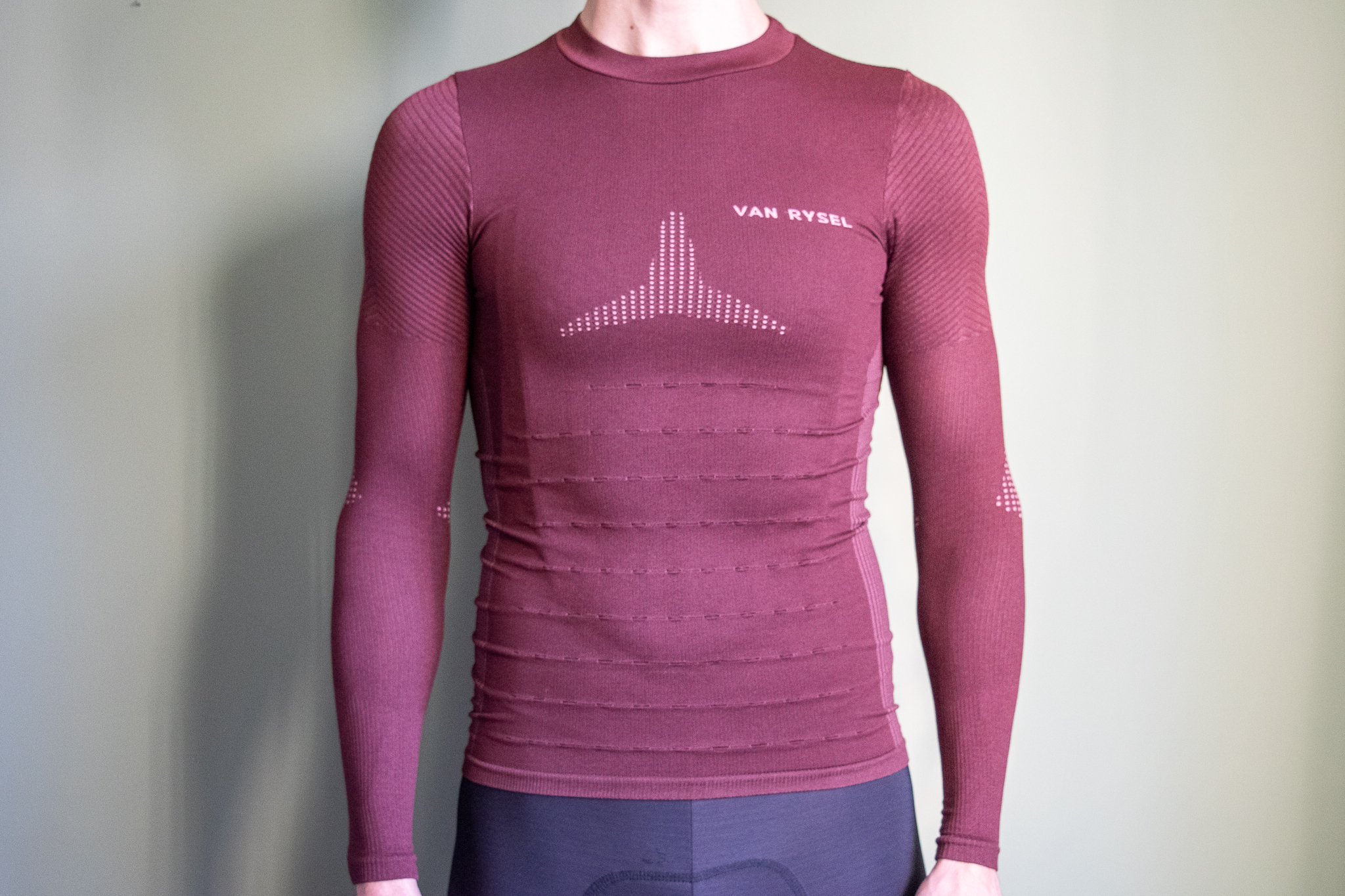
Specifications
Reasons to buy
Reasons to avoid
✅ You want an affordable winter option: The base layer offers great value. It's not too expensive and performs very well.
✅ You don't need lots of base layers: This is a thinner, stretchy base layer that still keeps you warm. You can pair it with lots of different layers to tackle a range of temperatures.
❌You ride in really cold temperatures and need something really warm: You may want something heavier duty for extreme cold or just to suit your preference.
I tested a few base layers from Van Rysel this winter, but the Racer 2 base layer stood out as my favourite and recommended piece. It's had an update for winter 2024 and the burgundy colour above is new.
I've gotten on well with Decathlon's (the brand's parent company) own brand base layers for years and had another solid experience with the company's Van Rysel brand. Van Rysel bikes and equipment are already featured in the WorldTour so the brand is casting off its budget roots to some degree.
Top tip; wash it first before using, the colour ran slightly for me onto a few other garments in the washing basket.
The Racer base layer is a medium-weight option but proved to be incredibly comfortable thanks to its high levels of stretch. The feel is actually along the same lines as the GripGrab Expert and the Assos skin layer for a fraction of the cost. I recently wore it for a few hours in pretty cold and bleak weather and it was very comfortable.
The base layer also has some light ribbing woven into the inside of the piece, to aid warmth and trap air more effectively. It's not as prominent as the Basez Extreme but it's along the same lines. If you don't want to spend too much on a good quality, winter base layer you can't go wrong here.
Best all rounder - Winter
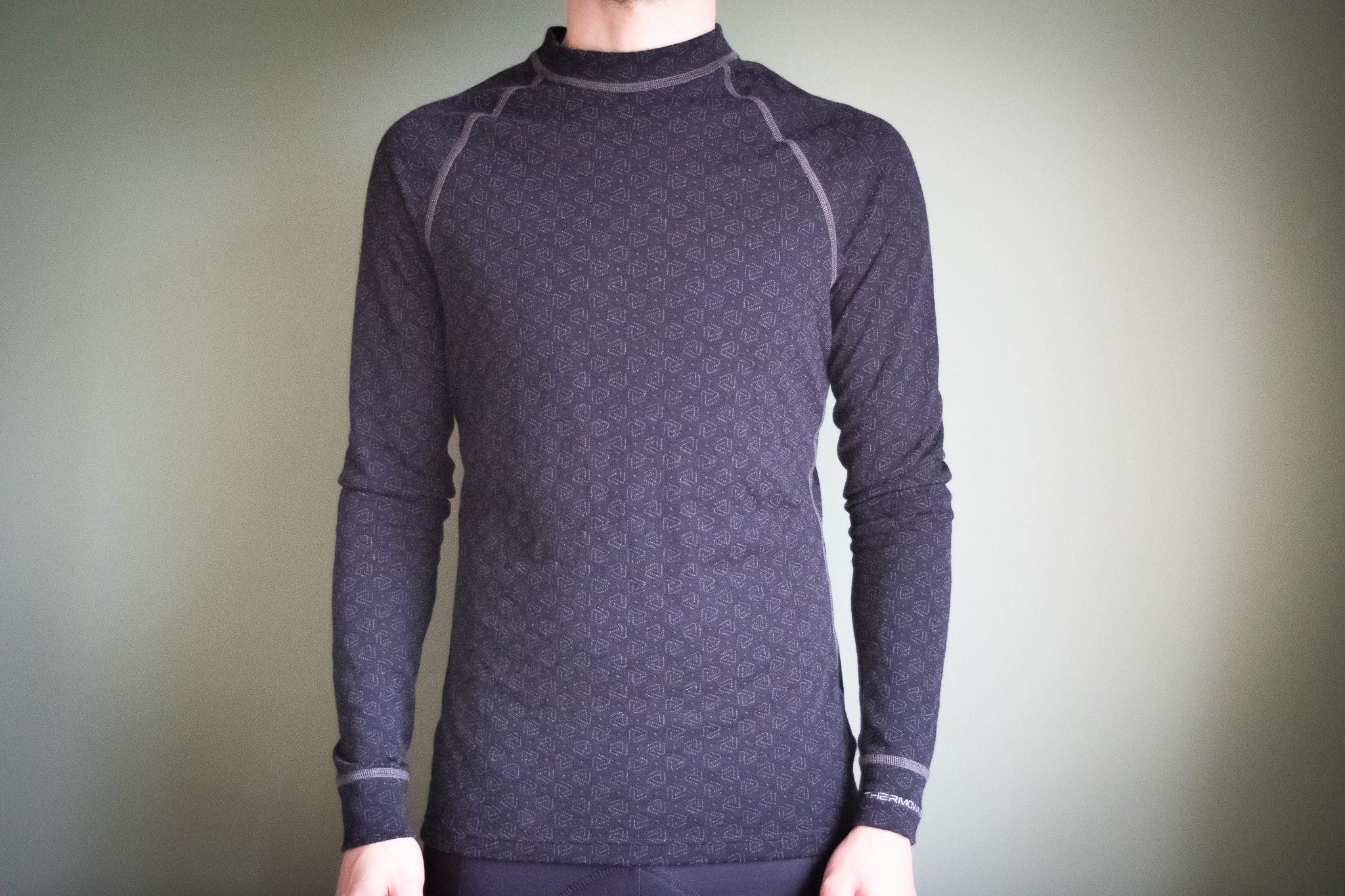
3. Thermowave Merino Xtreme long sleeve
Specifications
Reasons to buy
Reasons to avoid
✅ You want a snug, warm base layer and like the idea of using it for a bit of everything: The t-shirt-like cut and less fitted nature of the piece means it's perfect for more relaxed, less intense riding and even relaxing in at home or wearing as a base layer to walk in.
❌ Lots of your training or winter riding is more intense: This base layer will suit steadier winter riding more than hard intense road work due to its more relaxed cut and material.
I've included the Thermowave Merino Xtreme base layer here on account of its downright warmth and comfort. It's not a true cycling-specific base layer and is popular in climbing and walking circles, but it's a brilliant all-rounder for winter comfort.
It uses a Merino (80%) blend mixed with Polyester and Polyamide and is incredibly soft, comfortable, and warm. If you want a capable, luxury base layer to use on the bike under a winter jacket, for walking, or even for lounging in post-ride or wearing indoors - which is what I've been doing a lot in it - this is going to tick every box for you.
It uses 220 GSM material and a polyester interior lining to ensure there is no 'Merino scratch' when you're wearing it. It isn't a super close fit so is better suited to layering up on less intense rides. It's also available in a quarter zip version if this is your preference.
Also Tested - Winter
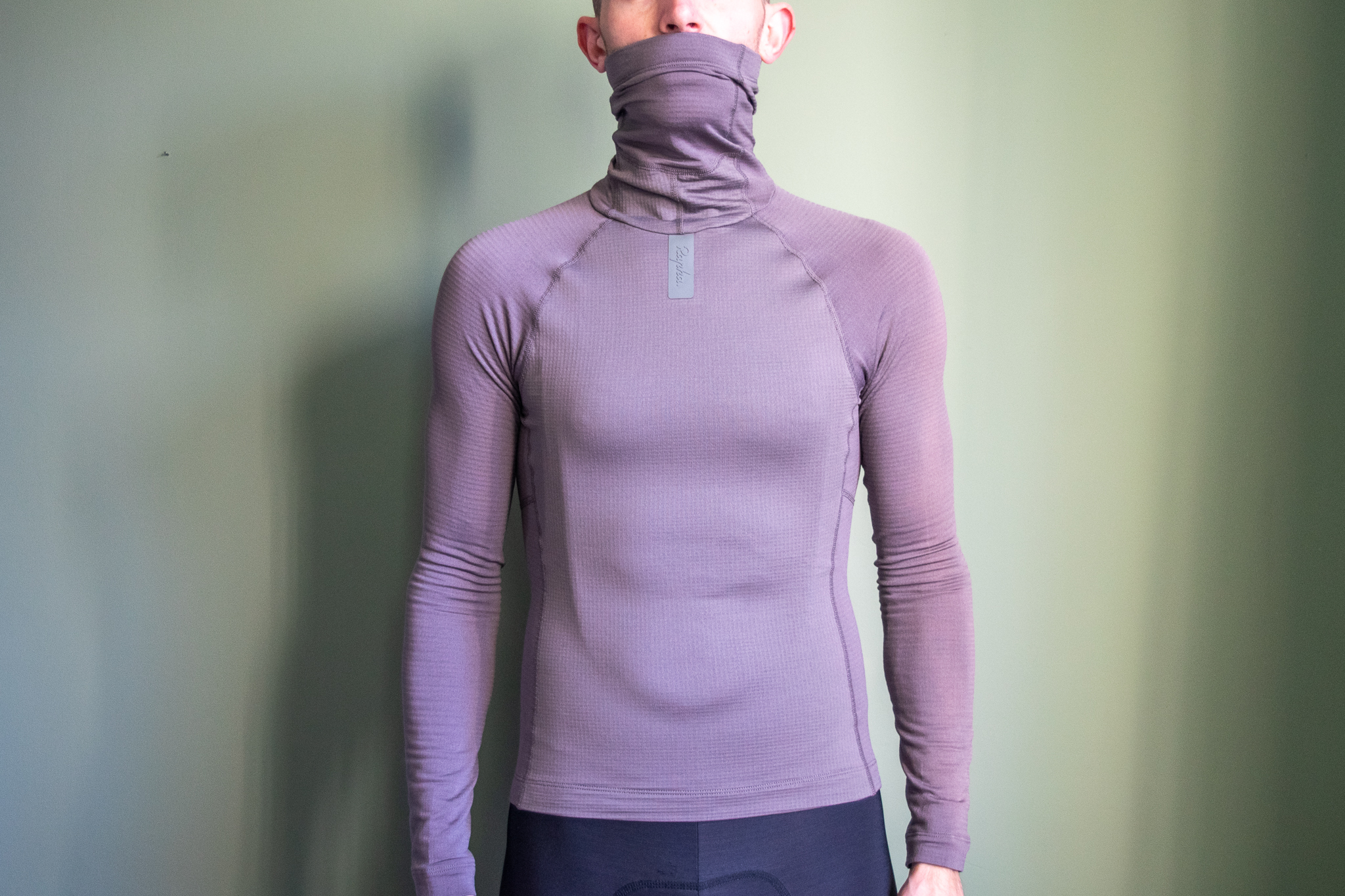
4. Rapha Thermal base layer
Specifications
Reasons to buy
Reasons to avoid
✅ You like the idea of an integrated neck warmer: The long neck is perfect for pulling up over your mouth and nose when that winter chill hits you as you begin a ride.
✅ You need to stay warm in really cold weather: The Powergrid material used here is very effective and adds a lot of warmth whilst being light.
❌ The long neck isn't worth the spend for you: Though the Power Grid material used is excellent, the protection from the long neck can be replicated by using a neck warmer or buff for less money.
The Rapha Pro Team base layer became the Thermal Base layer for winter 2024 but is essentially the same garment. It is a heavier-weight winter base layer designed to deal with everything winter riding conditions can throw at you. It's also one of the two garments in this guide to utilise Polartec Power Grid fleece. As mentioned, Rapha has updated it for winter 2024 and there's a new grey colour.
It is constructed from polyester and elastane and uses Polartec Power Grid fleece material on the inside which is designed to trap air and is a fabric it shares with the MAAP base layer in our test. The cuffs on the ends of the sleeves are doubled over to ensure a comfortable fit at the wrists.
The lengthy neck of the base layer is the standout design feature allowing you to use it as a warmer right up to the nose on those freezing mornings. Once things warm up you can then roll it down or just fold it over and you have an integrated neck warmer. This pretty much eliminates the need for a Buff. Some of the base layers in the guide have longer necks like Spatz but none offer quite the same length the Pro Team does.
The base layer is soft and comfortable and still pretty lightweight. It kept me warm and snug on some very cold days. Though it is at the more expensive end of the spectrum it will probably pay for itself in the long run if you are doing a lot of winter riding.
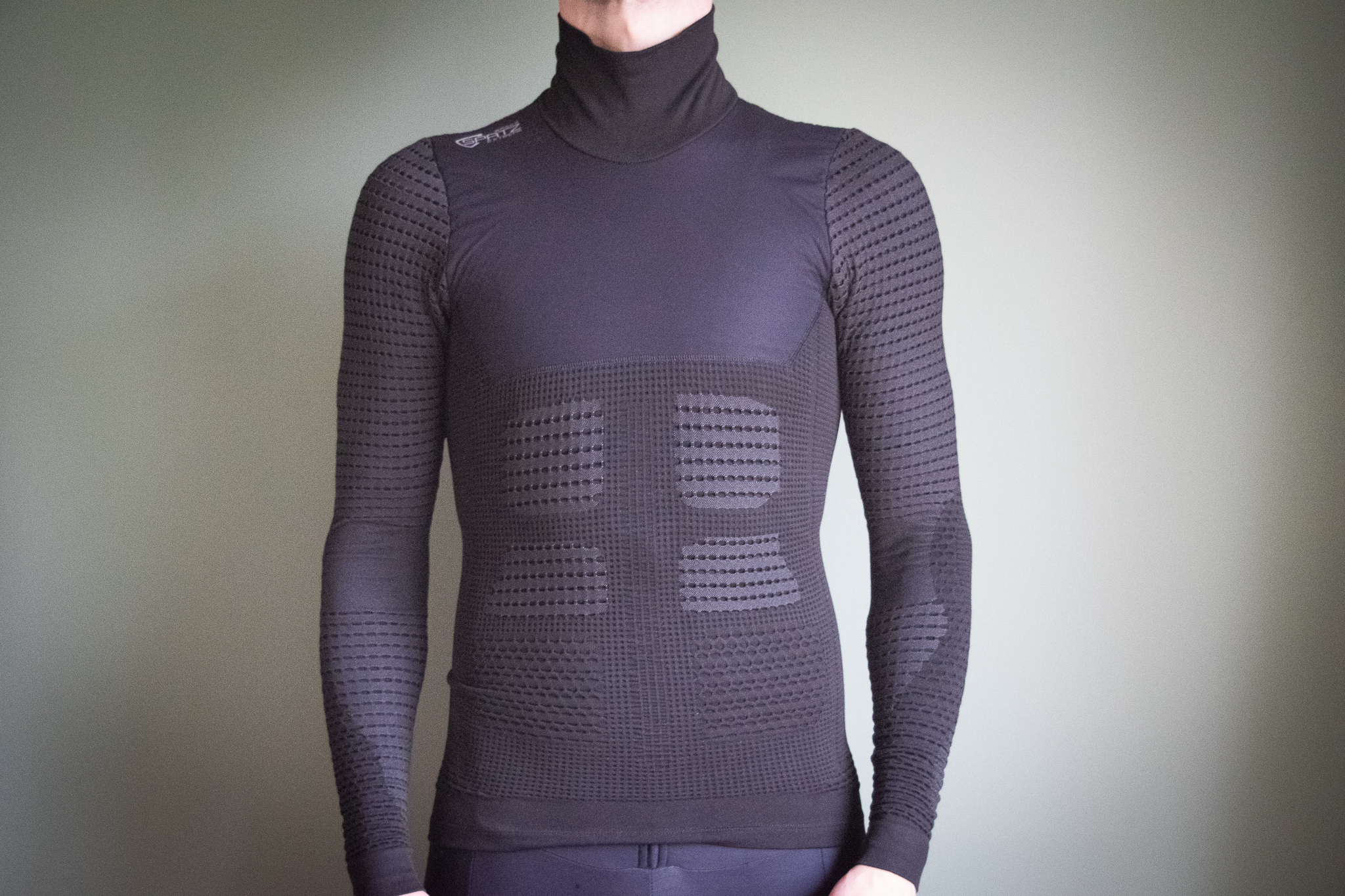
Specifications
Reasons to buy
Reasons to avoid
✅ You want heavy-duty winter protection: The Basez Extreme will help you feel ready to face anything. As a starting point under layers and a winter jacket, it will keep you comfortable and warm
✅ You ride hard in the cold: The Extreme is also tight and stretchy. I like to wear it on its own under a fitted gilet sometimes when riding hard and can then get away with wearing less on the bike.
❌ You tend to stay in if the weather is bad: This isn't the cheapest option and may just be overkill if you don't ride outside as much in winter.
❌ Like a looser-fitting base layer: This base layer is tight and stretchy and takes some effort to pull on. If you prefer a looser-fitting garment, check out the Thermowave option.
Spatz rolled out the Basez Extreme last winter, which by feel and weight is the most heavy-duty base layer in the guide.
If you're looking for a really heavy-duty base layer for a lot of cold, outdoor riding, head this way.
The Extreme uses differing weaves to create a waffle-like material which is designed to trap more warm air, and hopefully keep the wearer warmer.
A key difference between the older Basez 2 base layer from Spatz and the Basez Extreme is the fit. The Extreme is a lot tighter fitting and takes a little effort to pull on. Once in place though its stretchy material means it fits you snugly and it feels like a second skin once in place. I haven't found it too tight, or restrictive anywhere.
The Basez Extreme has an extended neck for extra protection and there is a windproof panel on the chest. It's thick enough to be into jersey territory and I like to wear it with just a gilet on top for a cross between warmth and lightweight on the bike when going hard, as well as for longer winter rides under layers and a winter jacket. Despite its heavy hitter billing it offers good versatility.
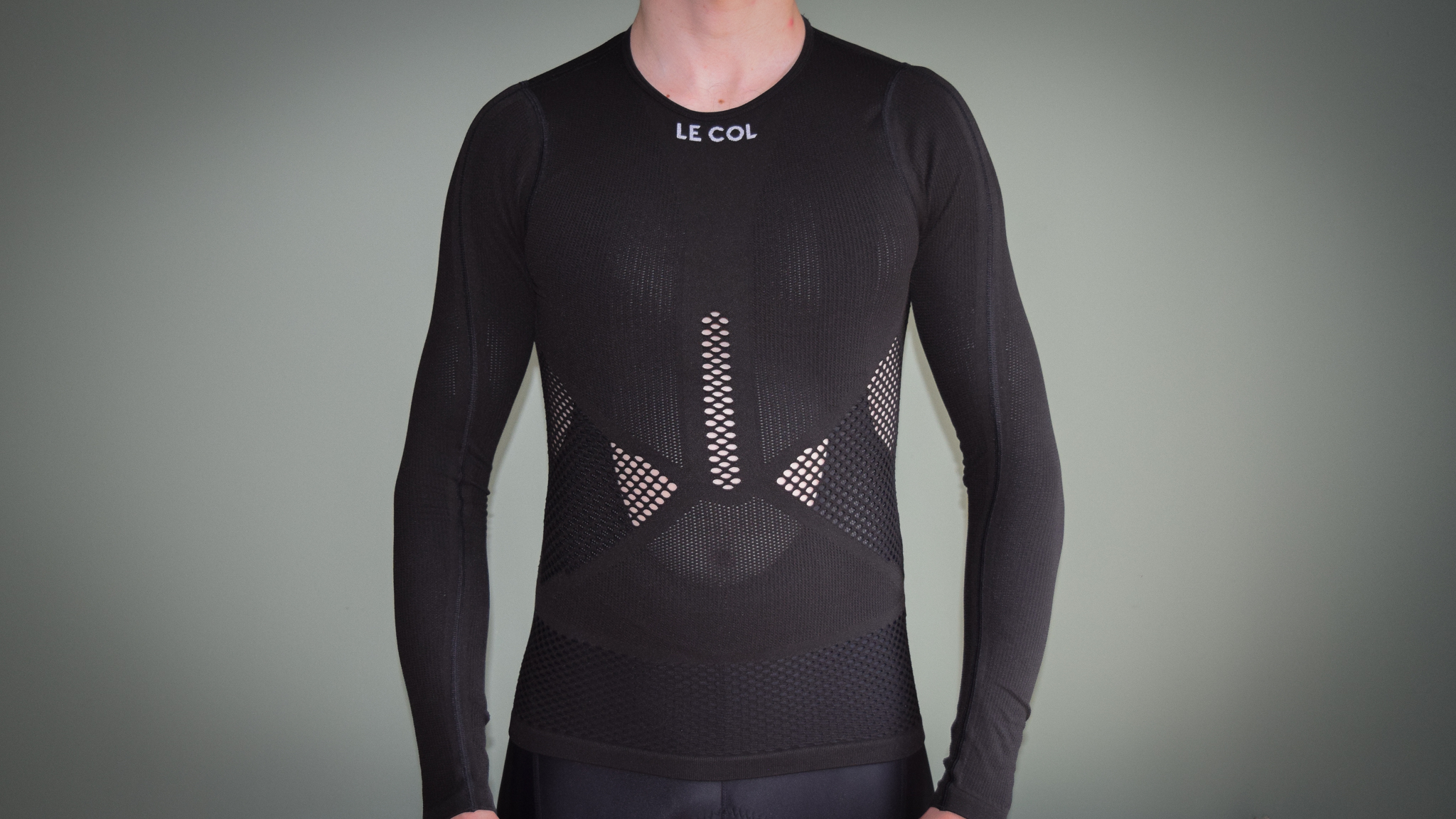
6. Le Col Pro Mesh
Specifications
Reasons to buy
Reasons to avoid
✅ You do lots of hard winter rides or races: The stretchy, thin nature of the base layer means it sits well under a tight-fitting kit and you won't overheat. In autumn I like wearing it under a summer jersey to stay warm, but light on the bike.
❌ Warmth is your priority: This is a more specific base layer for more intense riding. If warmth and comfort are your first concern, spend your cash on something like the GripGrab option.
Le Col's Pro Mesh base layer is a versatile long-sleeve base layer. It's woven in one piece and is very stretchy. It looks like it would be too small when held aloft, and visibly looked a lot smaller than any of the other base layers here, but don't worry it is true to size and will stretch to fit you.
The base layer has large mesh panels on most of the back and from the chest down on the front to aid cooling and to wick moisture effectively. The Pro Mesh doesn't carry quite the same thermal properties as some of the heavier-weight base layers in this guide, but I have found it a brilliant option for a cold, hard session where you are riding hard and sweating in the middle of winter and don't need the bulk of a thicker, heavier garment.
Alternatively, in the spring and autumn when temperatures are beginning to drop and you are just starting to reach for the long-sleeve base layers again, it works well. I've worn it several times under a short-sleeved jersey and not bothered with arm warmers for more intense sessions.
Its tight fit and lack of bulk would also make it an ideal choice for use in racing, for cyclocross for example or a local winter league or early season races whilst temperatures are still low.
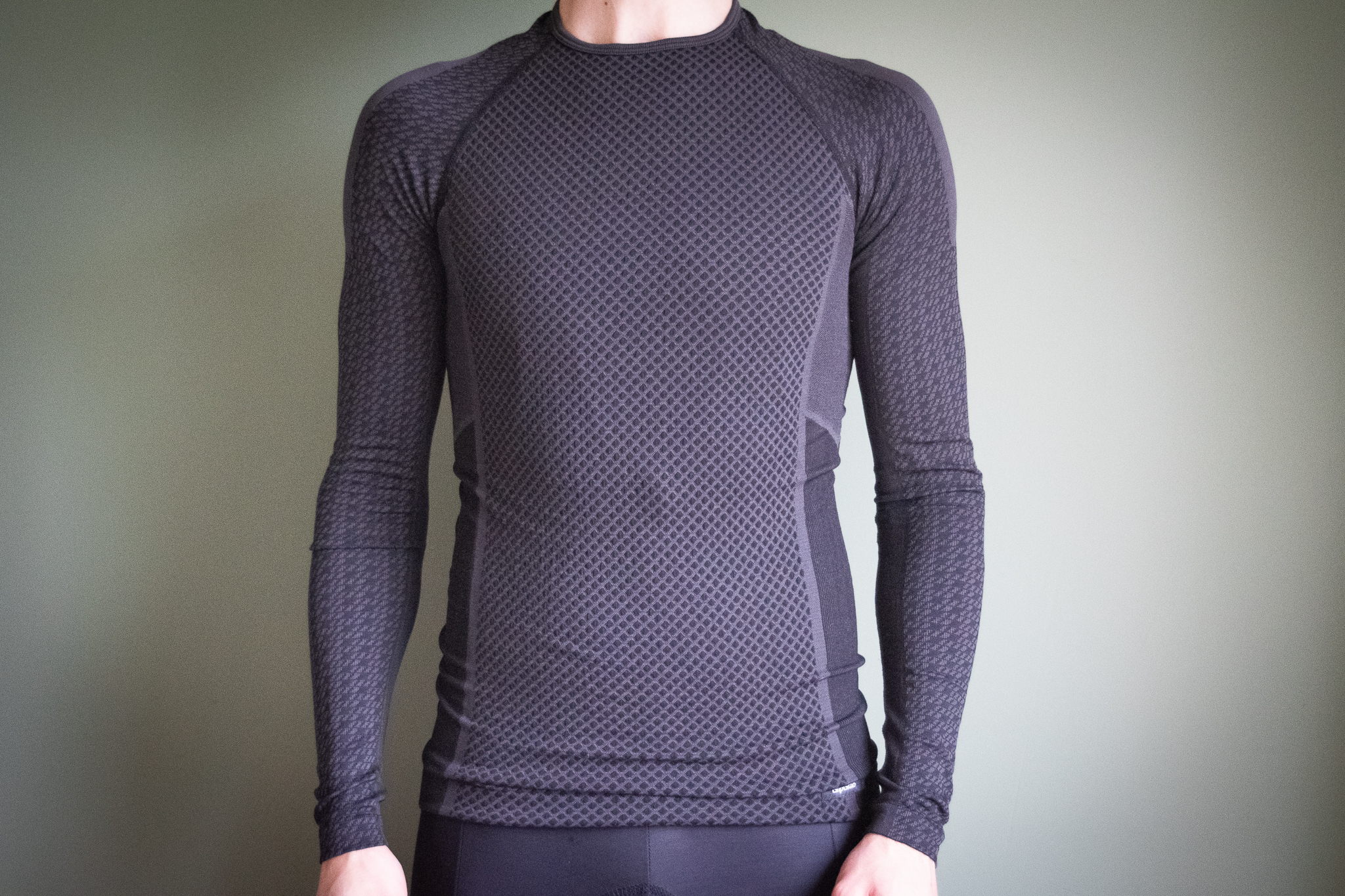
7. GripGrab Expert 2 Thermal Seamless
Specifications
Reasons to buy
Reasons to avoid
✅ You want a luxurious, warm base layer, but don't want to pay top dollar: This base layer feels really nice and plush when you pull it on, if you like the idea of a lovely snug layer for winter, but don't want to pay top dollar Assos money, this is a highly capable alternate option.
❌ You don't like a base layer to be too long: The base layer is true to size, but is quite long in length and will almost certainly require some tucking in, something to bear in mind if you aren't keen on this.
If you like the sound of the Assos LS skin layer but don't want to pay top dollar, the Expert 2 Thermal from GripGrab is worth a look. It sits at a competitive price point at around half the Assos option but offers a stretchy, compressive fit and has a very soft, luxurious feeling.
GripGrab pretty much specialises in foul weather kit and the second version of the Expert base layer is going to keep you warm and comfortable on winter rides. It's a little longer in length than some other base layers here and you can comfortably tuck it into shorts or tights for added warmth.
It's a heavier weight base layer, and for me will suit being worn under a winter jacket or jersey rather than tighter racier kit.
It also uses Polygenie fabric treatment which should help keep things that little bit fresher.
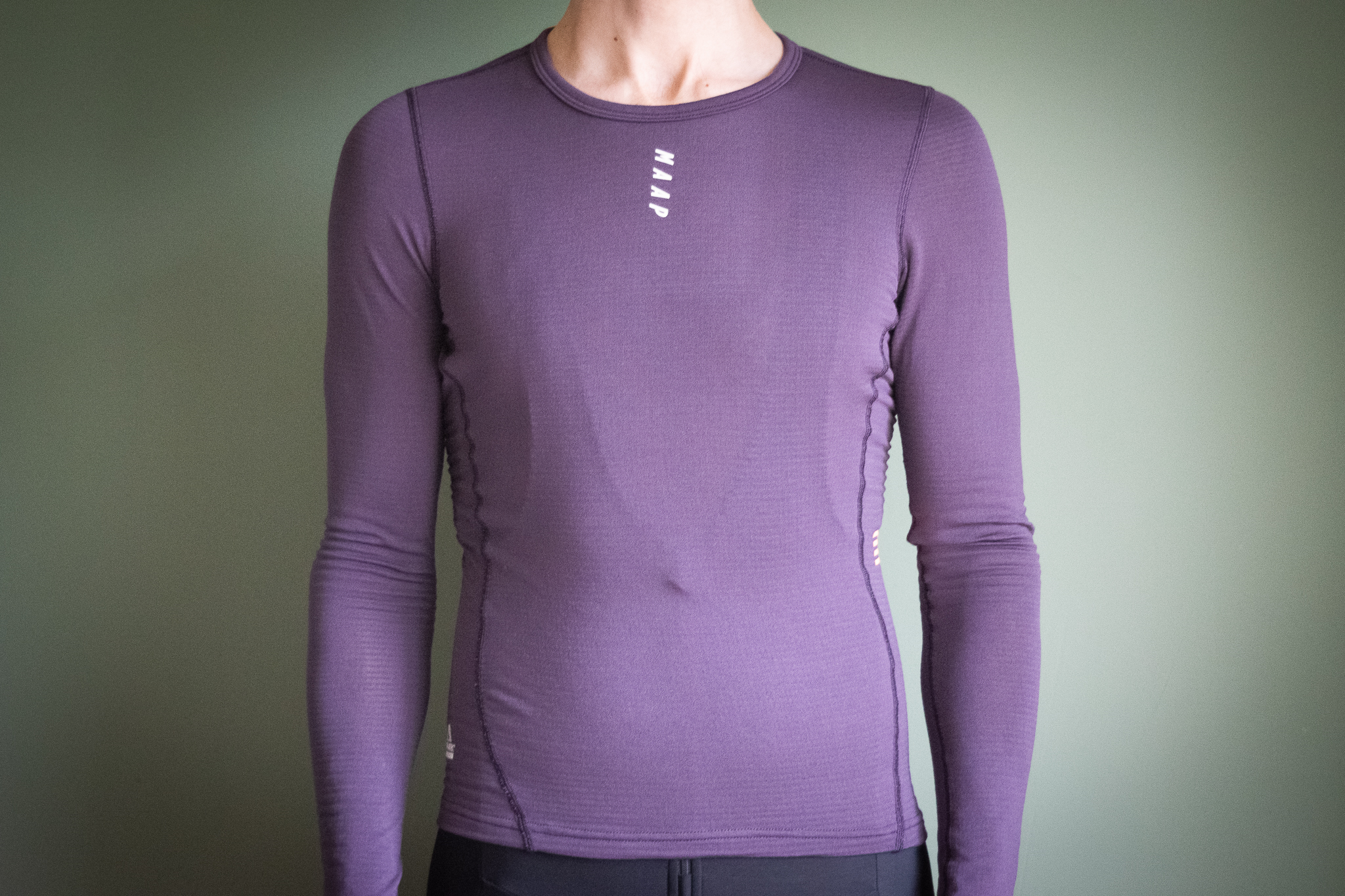
Specifications
Reasons to buy
Reasons to avoid
✅ You want a lightweight, warm base layer: The Power Grid material used here is excellent. I've been caught out several times by this base layer and ended up too hot. It's deceptively warm, if you want something thin and lightweight yet warm, this is one of the best options.
❌ You tend to run hot: Despite its lightweight feeling this is a warm base layer and you may find yourself wishing for something a little cooler.
The MAAP thermal base layer is a stylish long-sleeve winter unit that utilises Polartec Power Grid fabric. The base layer is more of a mid-weight piece but packs a punch in terms of outright warmth.
The Power Grid takes the form of tiny raised squares of fleecy fabric all over the inside of the base layer. Polartec states this technology strengthens warmth and breathability while reducing fabric mass and also aiding wicking. The purple colour I have the base layer in is no longer available but there are five colours to choose from.
The thermal base layer is another deceptively warm unit and I made the mistake of wearing it on a ride where temperatures rose up to around 10 degrees (or 50 degrees Fahrenheit) with a winter jacket and I ended up being far too warm. The Polartec Power Grid material does an excellent job of creating extra warmth.
Take a look at our in-depth review of the MAAP Thermal base layer here.
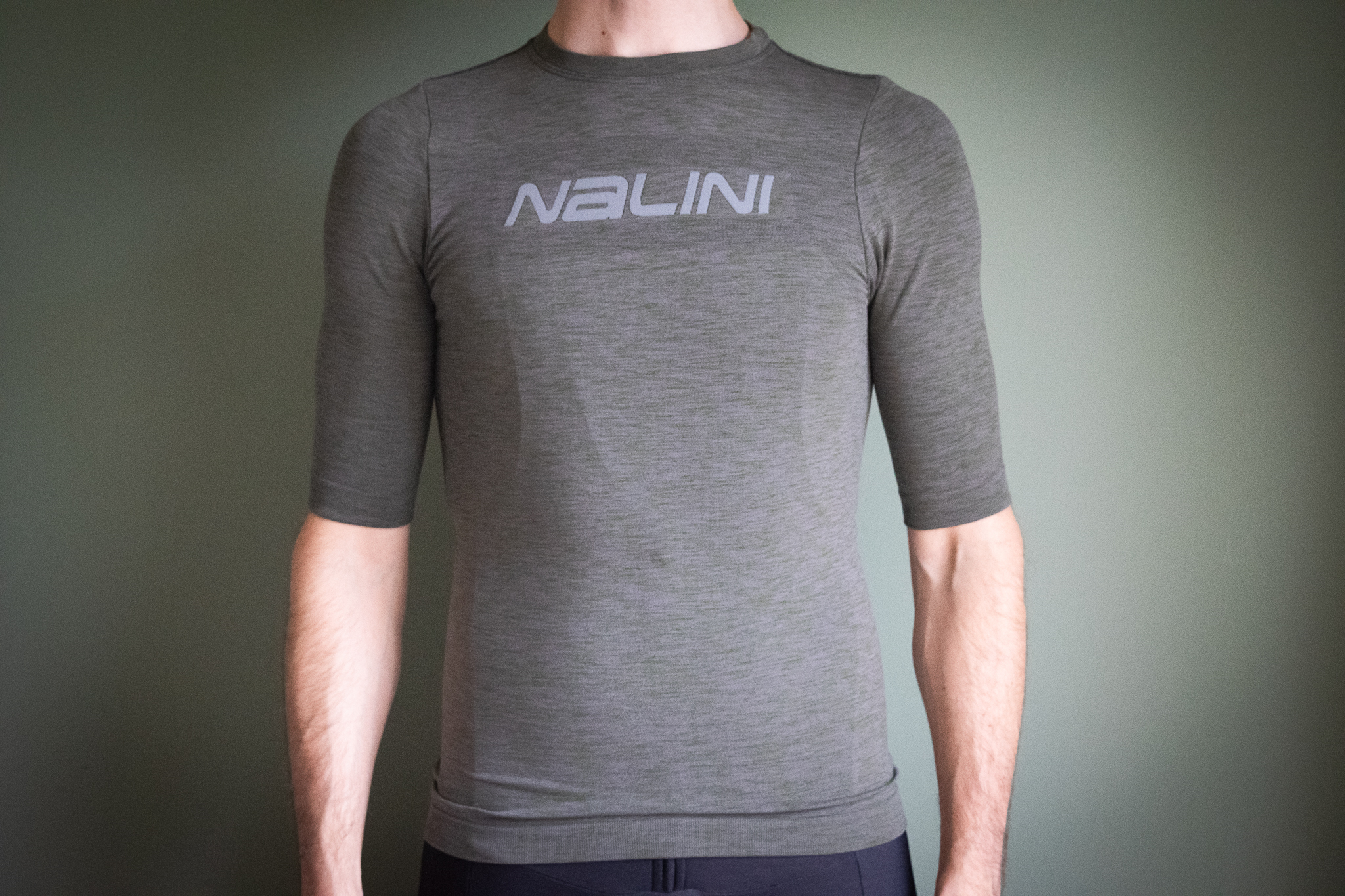
9. Nalini Melange base layer
Specifications
Reasons to buy
Reasons to avoid
✅ You want a heavier weight, short sleeve base layer: This is a comfy and versatile piece that lends itself well to a range of different layering to suit the conditions.
❌ You prefer long sleeves: Certain winter jackets feel a little uncomfortable against bare skin. If you prefer the simplicity of a long-sleeved base layer for winter, perhaps give this one a miss, as it is a touch more specific.
The Nalini Melange is a great short-sleeved, winter weight base layer option if you want to wear a little less or even add warmth in summer. It's stretchy and has a fantastic premium feel and cut with long sleeves extending down to just above the elbows. I've worn it to add warmth on colder days under a jersey with arm warmers.
It does feel really luxurious and nicely compressive, which I think the compressive material contributes to.
The fit is similar to a nice summer jersey, especially with the longer arms and it's paired well with several of my similarly cut short-sleeved jerseys. This makes it a great option for cooler autumn and spring rides where the weather is changeable, but you can wear it comfortably into winter as well.
Summer base layers
A good summer base layer will wick away heat and sweat quickly, without adding too much bulk, allowing good airflow over the body to help you to stay feeling comfortable.
Best Overall - Summer
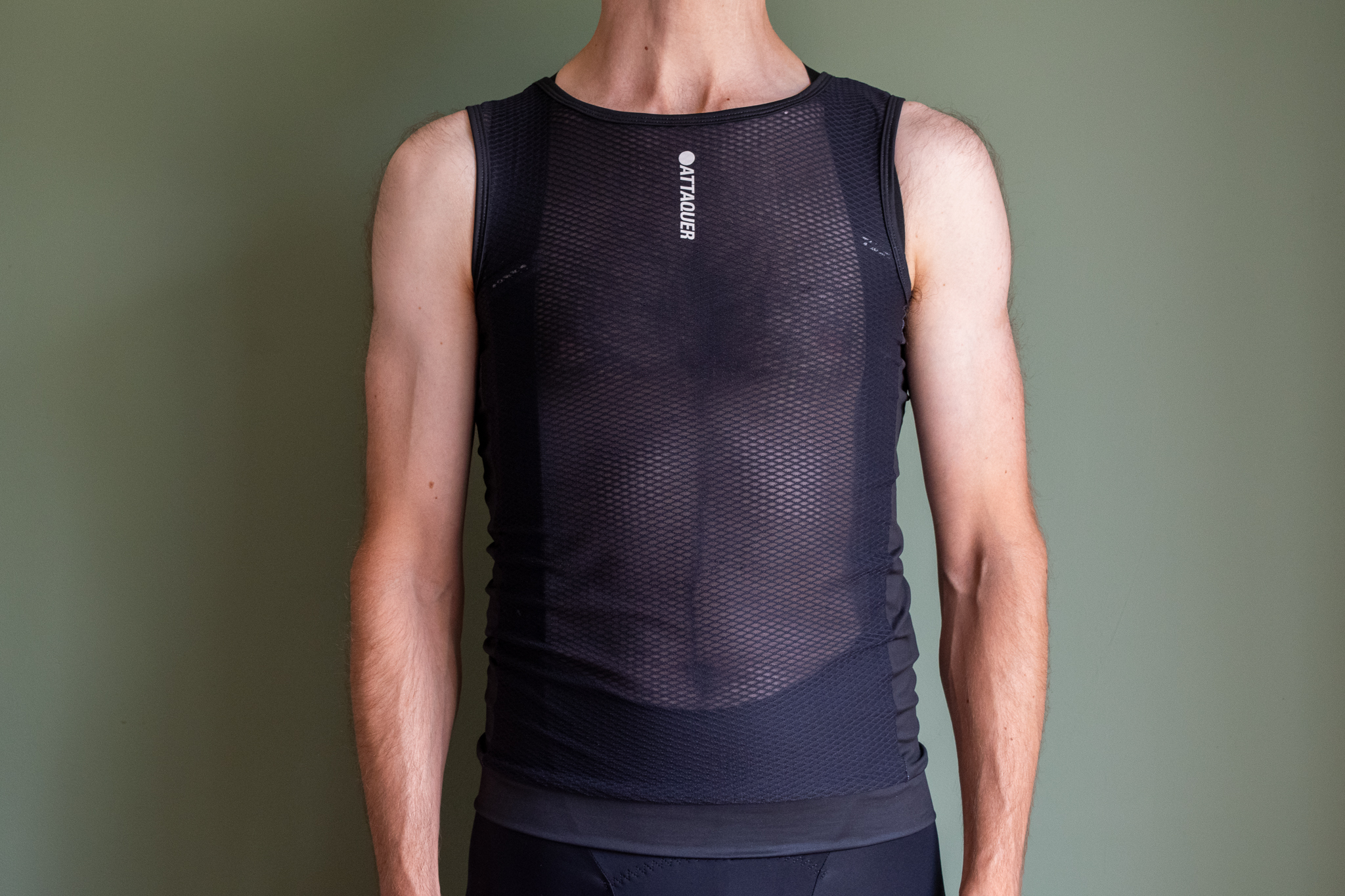
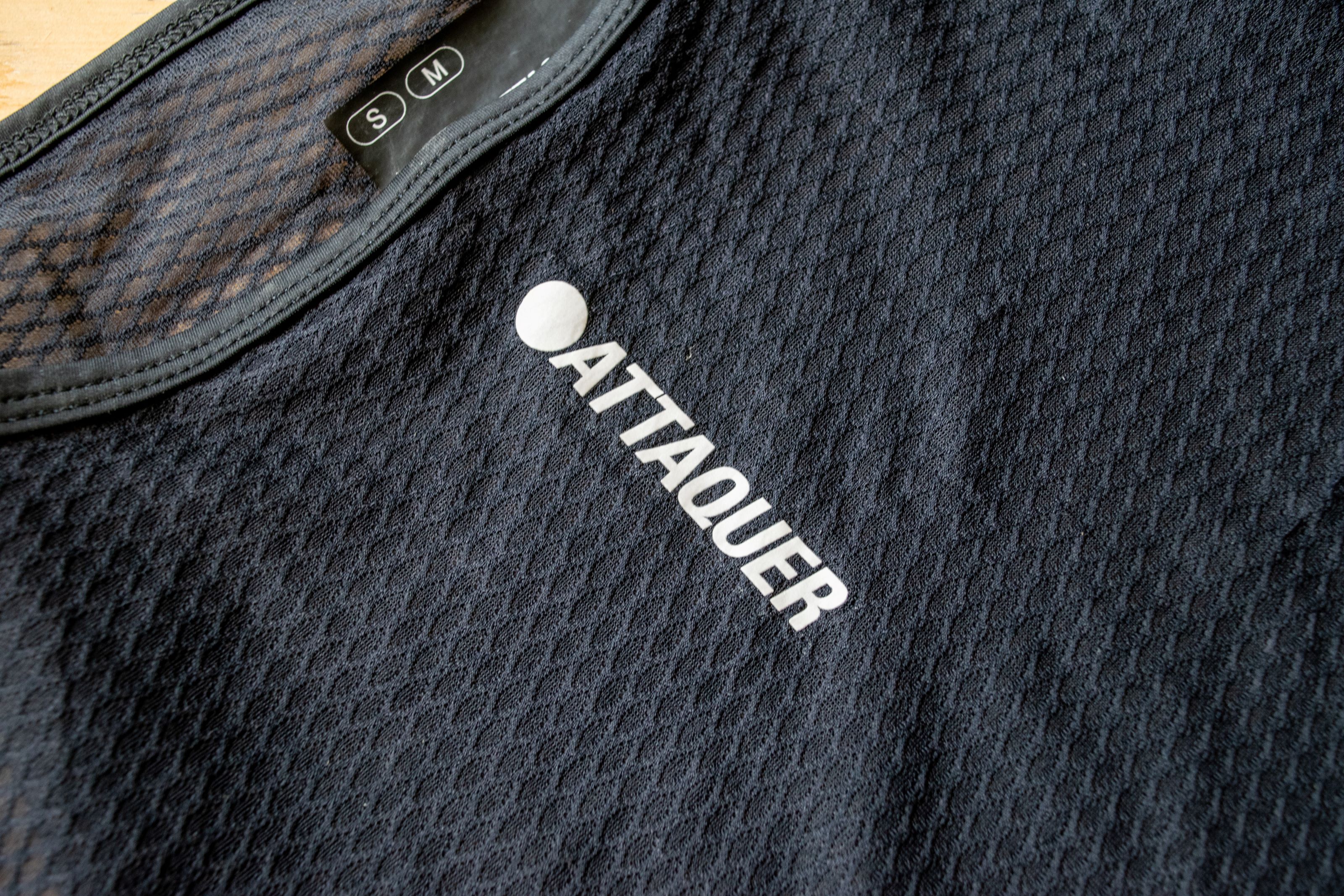

Specifications
Reasons to buy
Reasons to avoid
✅ You want to buy a light, comfy base layer for summer
✅ You will want to wear it under tighter jerseys
❌ You aren't so keen on the translucent material
❌ You like a short torso - there's a bit of extra length in this one
I've ridden for over 13 hours straight in the Attaquer Summer base layer and it was nothing but comfortable with zero chafing or irritation. I wouldn't hesitate to use it for my longest rides and it takes the best overall spot for summer base layers.
The Summer base layer is a polyester/elastane mesh mix with stretchy wide side panels and hem. It feels really soft and comfortable when you pull it on, and this feeling remains in use. I've reached for it a lot this summer and it's one of the most comfortable base layers I've worn.
Sizing is staggered, I've tested the S/M and it's closer to a lot of other brands' small in my opinion. However, the fabric does have a lot of stretch if you're closer to a medium.
You can read our full review of the Attaquer Summer base layer for more details.
Best Merino - Summer
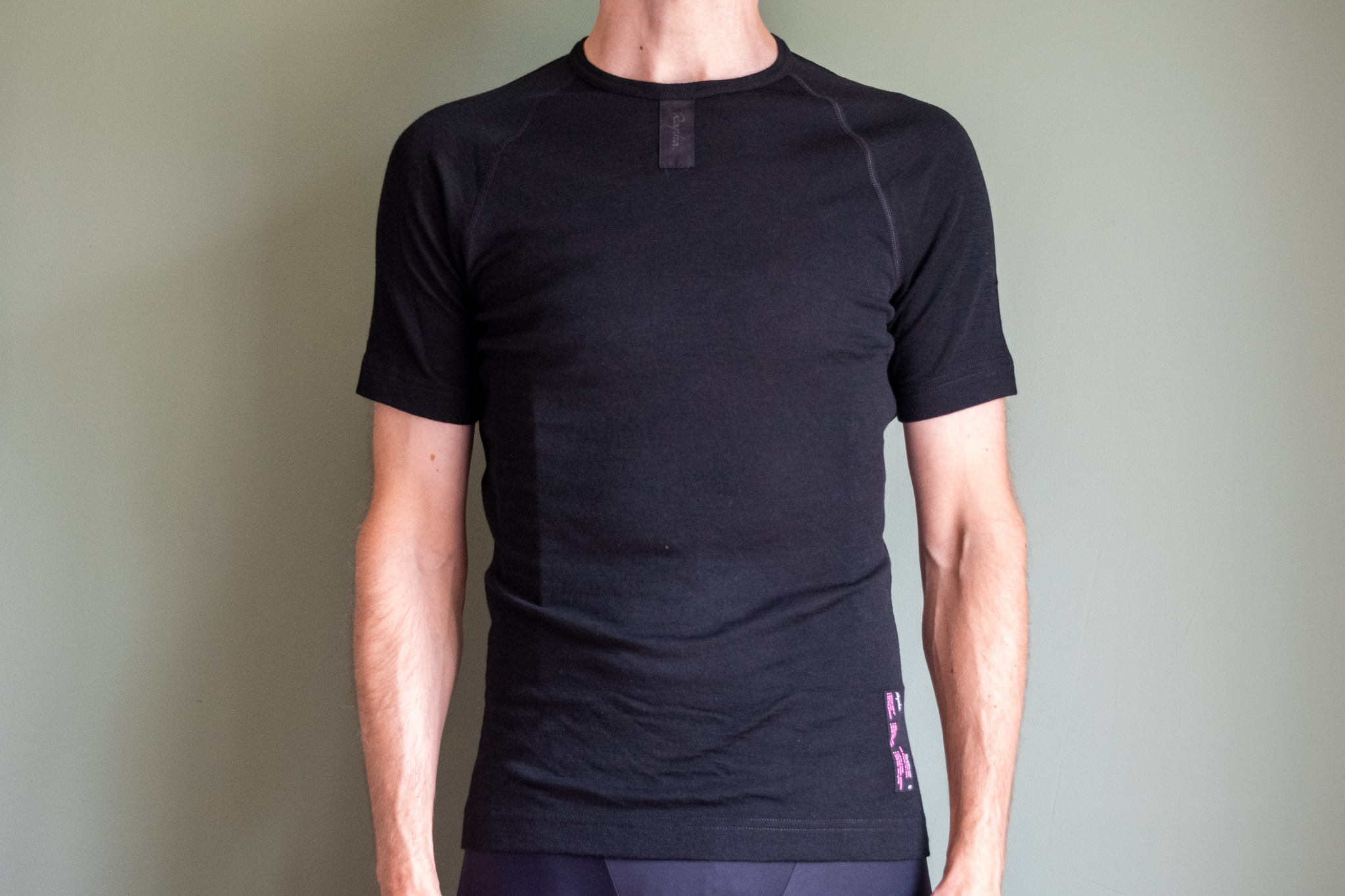


Specifications
Reasons to buy
Reasons to avoid
✅ You want to add a quality merino piece to your cycling wardrobe
✅ You do lots of slightly less performance-focused cycling and want something for a range of temperatures
❌ You are often racing and training and wearing tight aero kit
❌ You prefer minimalist, superlight base layers
Rapha overhauled its base layer offerings this year and a new model in the range is the updated short sleeve merino base layer, a 100% merino wool, short sleeve base layer.
I noticed how soft the Merino base is as soon as I pulled it on, and it's certainly one of the most comfortable layers in the guide. It has a slightly more relaxed cut, which means you can do a lot with it. Wearing it under a jersey or even on its own for gravel or more relaxed riding. The slacker cut of the hem fits a little more like a t-shirt which helps this and I have worn it around the house to relax in. I also got back from over two hours on my gravel bike with it feeling dry and sweat and odour-free.
Although it's a summer weight, you could also wear this piece as part of your winter layering strategy making it even more versatile and useful, and boosting the value for money. At the time of writing it's discounted on the Rapha website, but even at full price it's a good buy and would make a very useful addition to most cycling wardrobes.
It won't fit as well under a tight-fitting or aero cycling jersey due to the fit and less stretchy merino wool. Check out the Nalini Melange or GribGrab Windbreak short-sleeve options in the winter section for a heavier-weight short-sleeve base to wear under a tighter jersey.
You can also read our in-depth review here.
Best Value - Summer
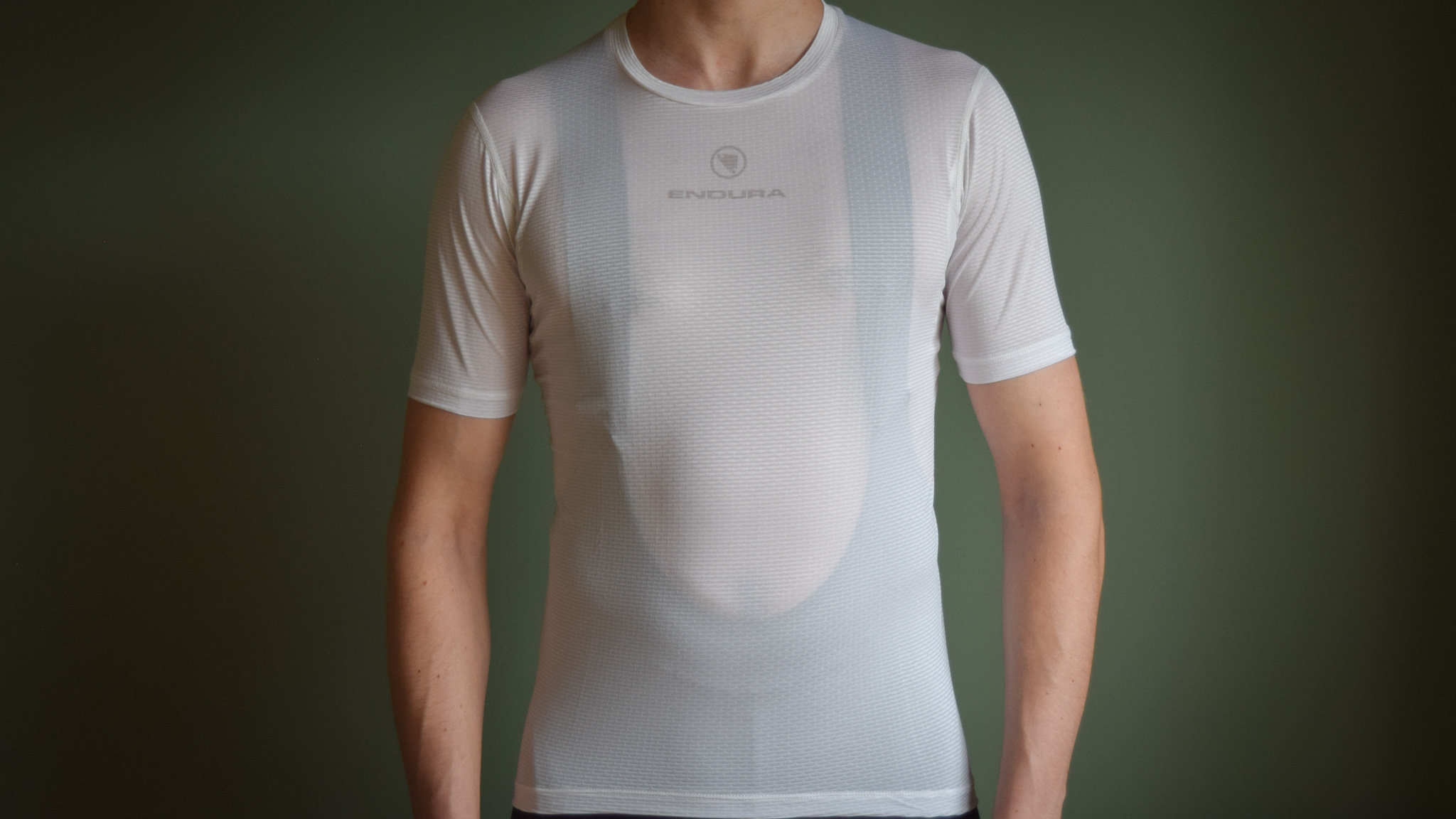

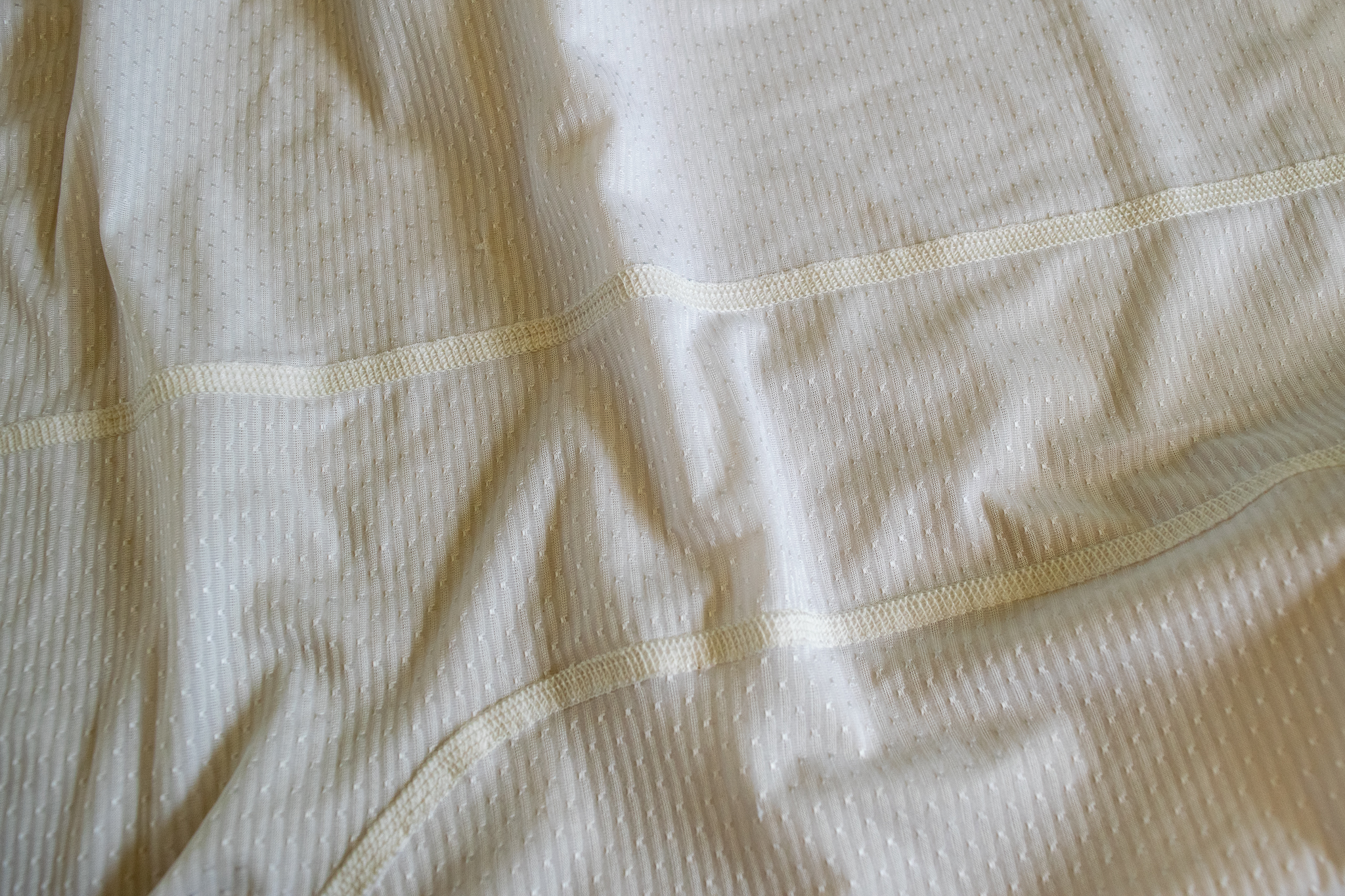
Specifications
Reasons to buy
Reasons to avoid
✅ You want to buy a good quality all-rounder at a strong price
✅ Value a comfy base layer; this one is really soft
❌ You like tighter fitting base layers with more compression
❌ Lots of your favourite jerseys have longer, tight sleeves
The Endura Translite II base layer is constructed from a super soft and fine polyester mesh that's partly recycled. It's available in sleeveless and short-sleeved variants. There is also a Windstopper version. I however tested the short sleeve version.
It's also good value for the performance, with a price tag less than half of some of the most expensive options here.
The Translite is amongst the most comfortable base layers in this whole guide. It's super soft and comfortable with flatlock seams and the cut is ever so slightly more relaxed than some of the other more tightly fitting race cut base layers here. This adds a little bit of versatility and you could even wear it as a base layer for a walk or run.
It kept me comfortable and wicked sweat well on the smart trainer and riding outdoors, and for the price is a really solid base layer option.
It's only available in white, has a silver Endura logo on the chest and the label is soft and sewn into the rear of the neck, as you can read in my full Endura Translite II base layer review.
Also Tested - Summer
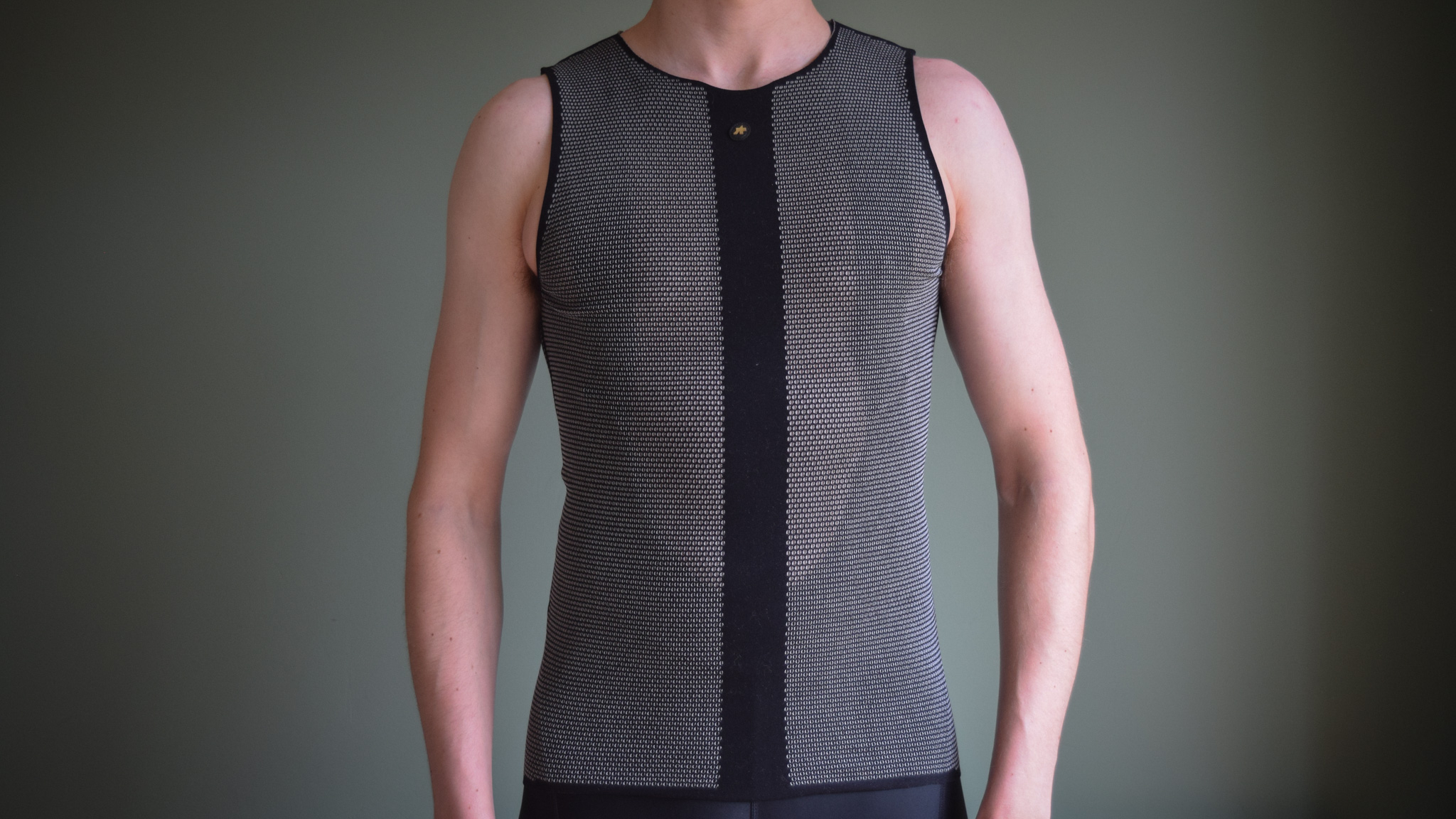
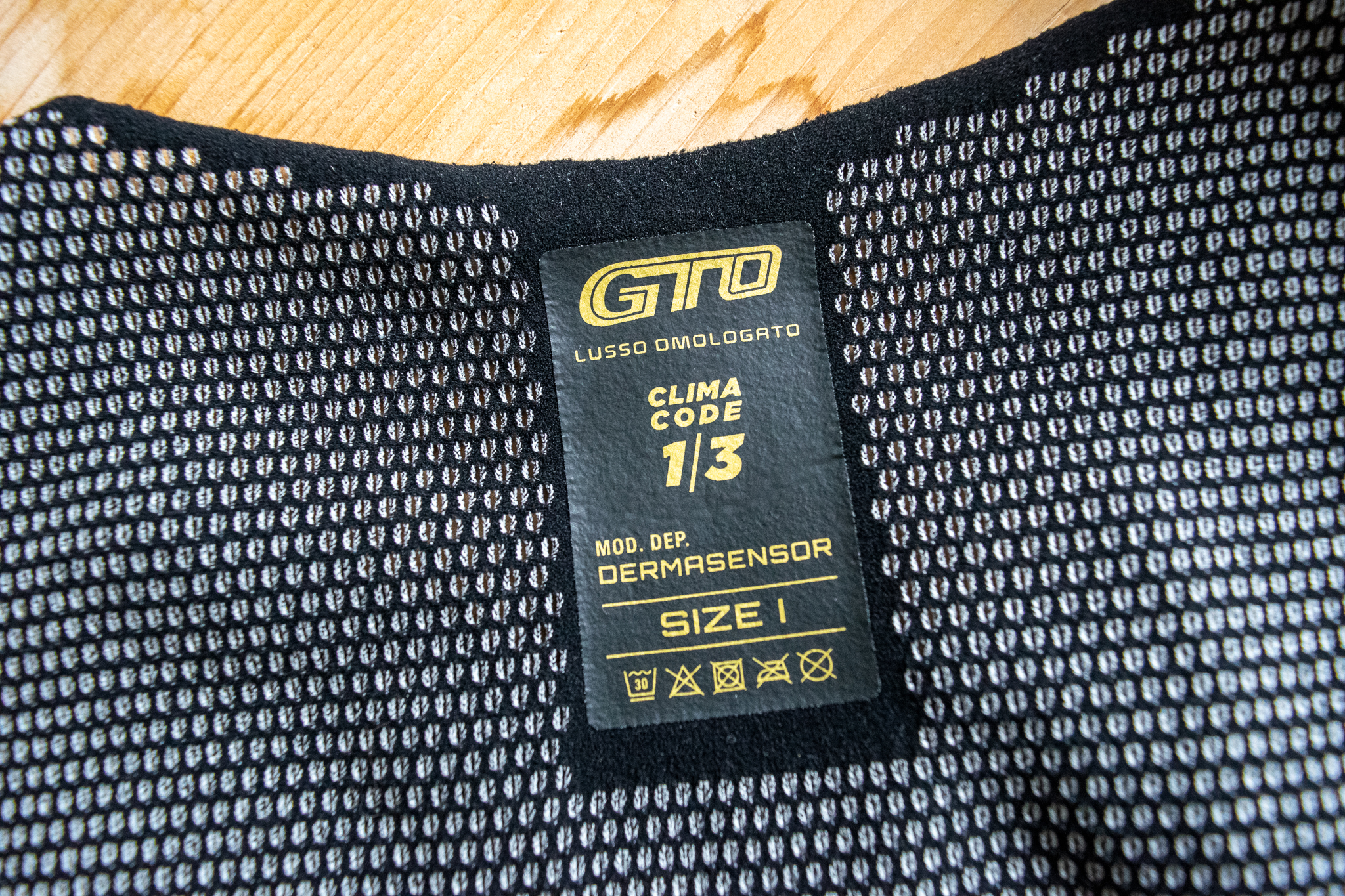
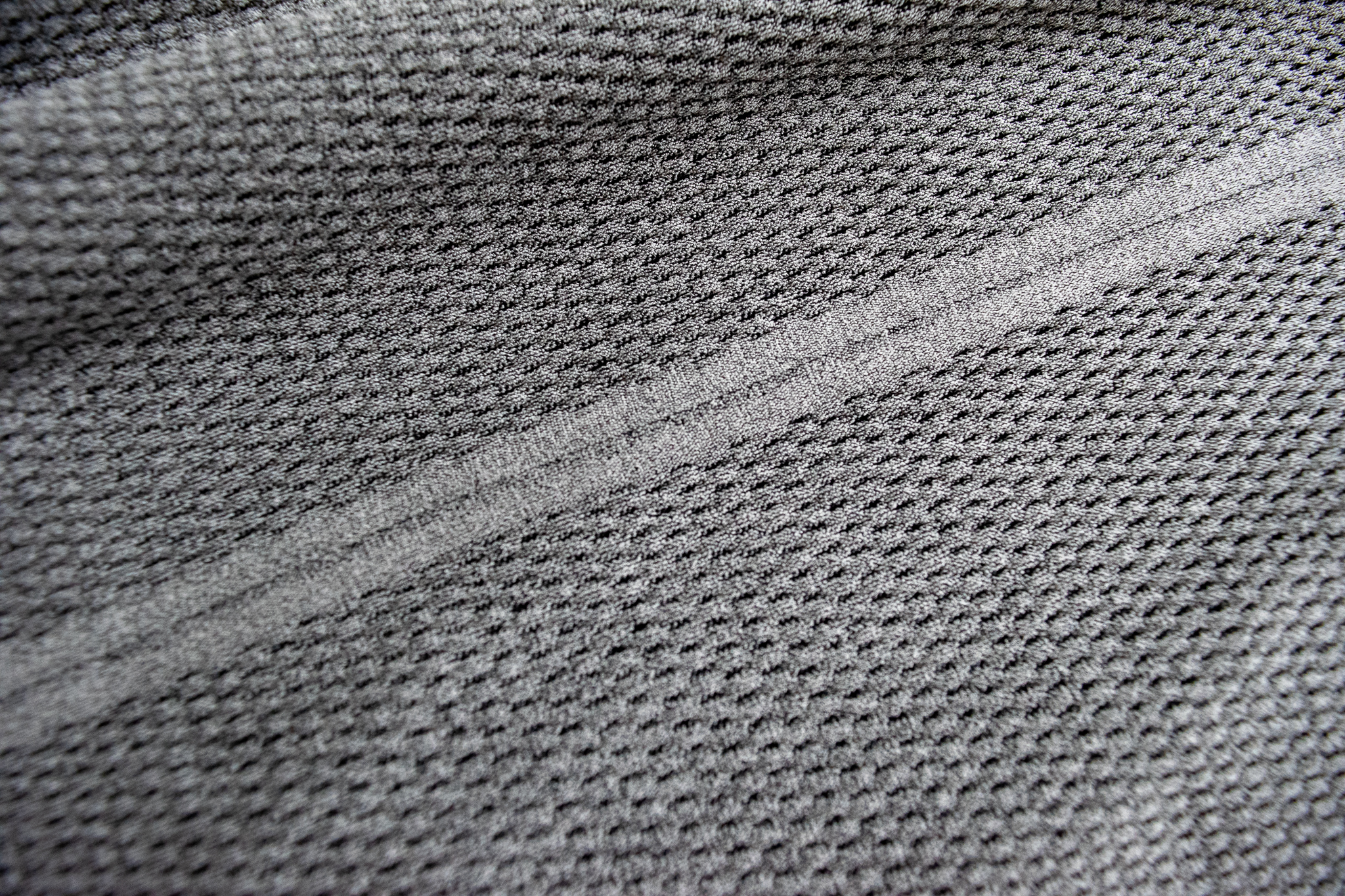
4. Assos GTO NS DermaSensor
Specifications
Reasons to buy
Reasons to avoid
✅ You value the very minimal seams and want to minimise potential hot weather chafing or irritation
✅ You are invested in the Assos brand already and want to try its summer range-topper
❌ You would rather save your cash for other more pressing purchases and upgrades
❌ You don't wear a base layer much in the summer anyway
The GTO NS Dermasensor is the top-tier summer base layer from Assos and is the most expensive base layer in the test.
Using a mesh construction except for the Assos solid line down the front of the chest, the Dermasensor is super soft and form-fitting. There are zero seams or labels apart from some minimal stitching at the shoulders and it makes for a very comfortable experience and aids layering. The mesh holes themselves are larger than most of the other base layers here and really open up when stretched which aids cooling.
Aesthetics-wise, the greys and black sit nicely against the Gold Assos logo, and whilst aesthetics don't really come into play when covering base layers, it does look classy.
I've worn it on hot climbs in Mallorca and on the cobbles of the Paris-Roubaix Challenge and it's always performed very well. It actually feels medium weight in thickness but acts like a far lighter-feeling base layer.
Needless to say, I've found the Dermasensor incredibly comfortable and soft to wear and it's performed excellently across all test rides. If you want to splash the cash for one, it won't disappoint.
Owners also benefit from a two-year warranty and crash replacement policy from Assos.
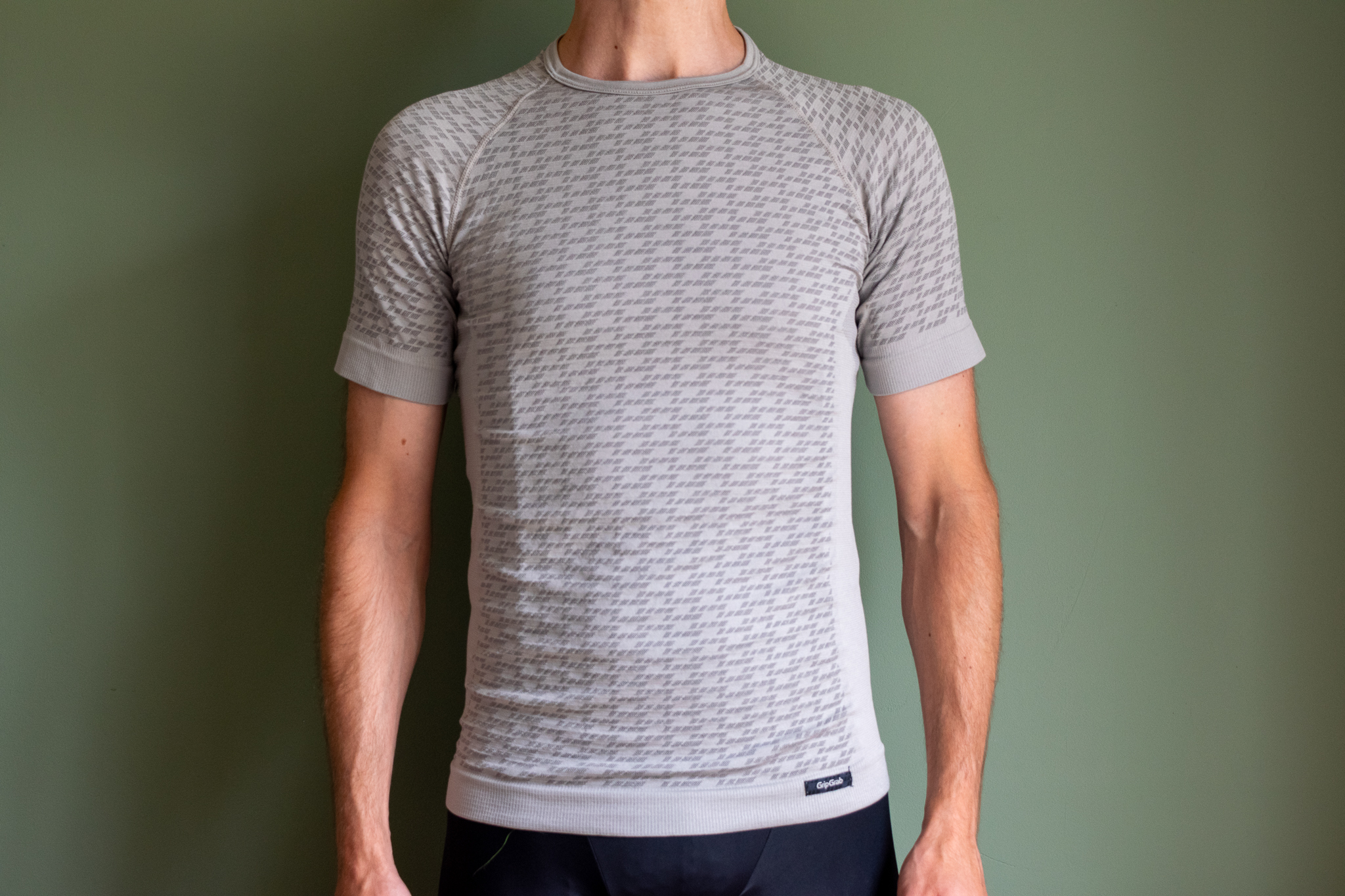

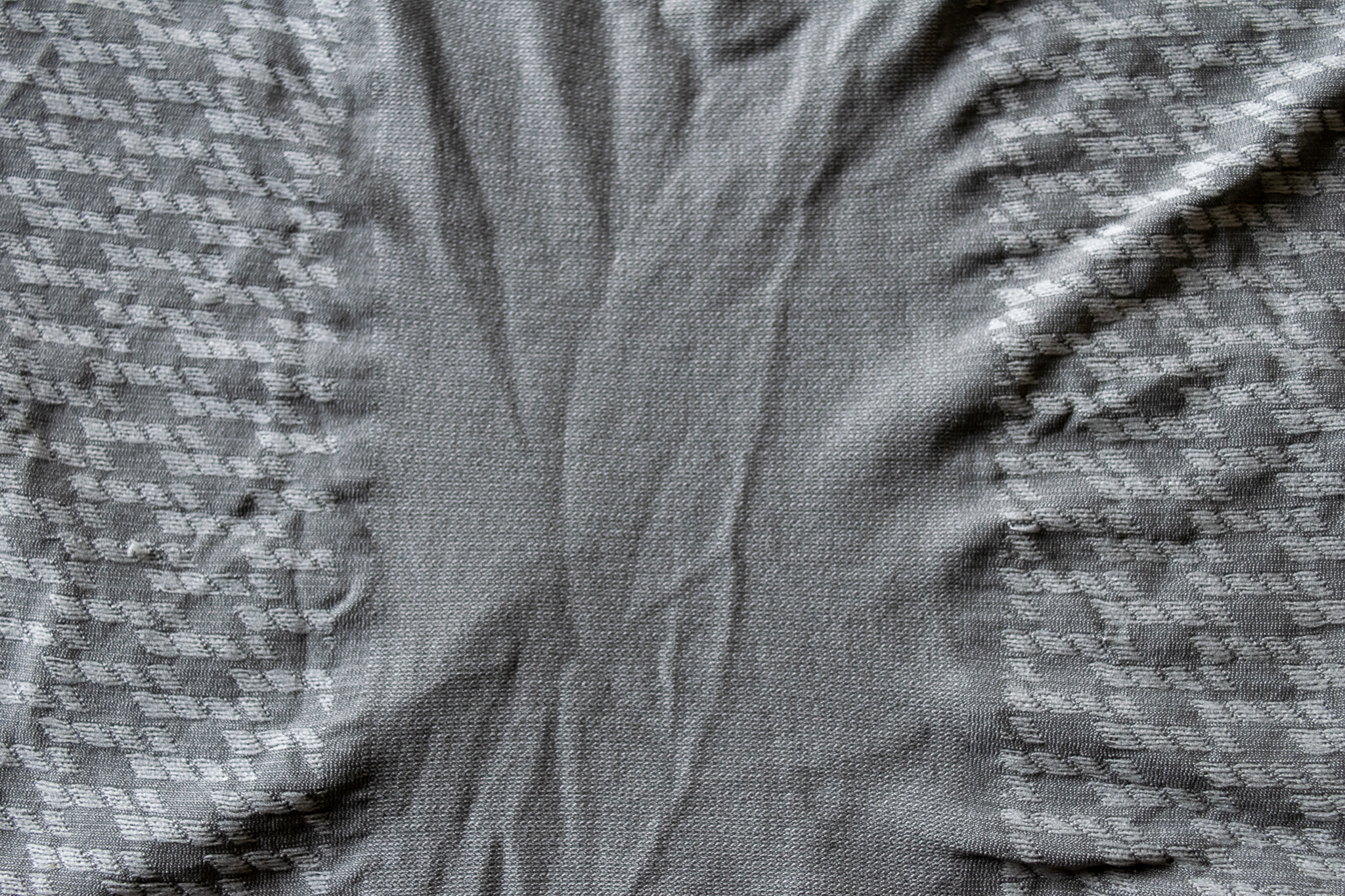
5. GripGrab Expert Seamless
Specifications
Reasons to buy
Reasons to avoid
✅ You don't get on so well with Polyester base layers
✅ Want a super soft base layer
❌ You prefer a superlight base layer for summer use
❌ Live somewhere with really hot summers
The GripGrab Expert Seamless base layer, is, you guessed it, a seamless base layer that's seriously soft and comfortable. It's incredibly soft to the touch even handling it, and pulling it on feels great.
The tubular body of the piece is seamless, the only seams to be found are on the arms and GripGrab has chosen polypropylene fabric over polyester which it says is quicker drying and stays fresher. There are also mesh 'vents' under the arms which are there to aid cooling and deal with sweat.
I found my XS/S piece to fit like a regular small, and the base layer has a good amount of stretch. The comfort on offer is up there with the best in the guide and it will suit a wide range of uses.
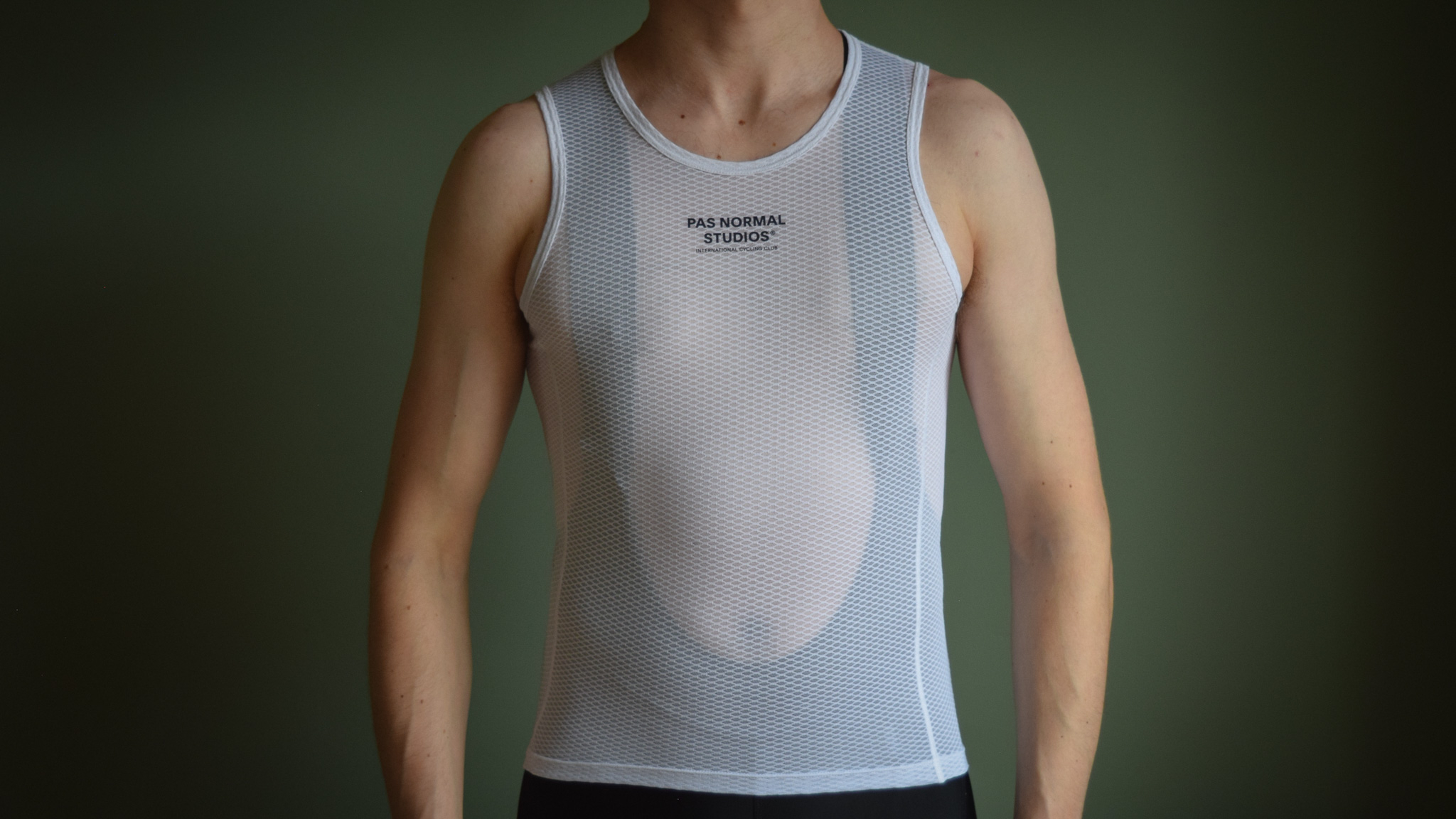
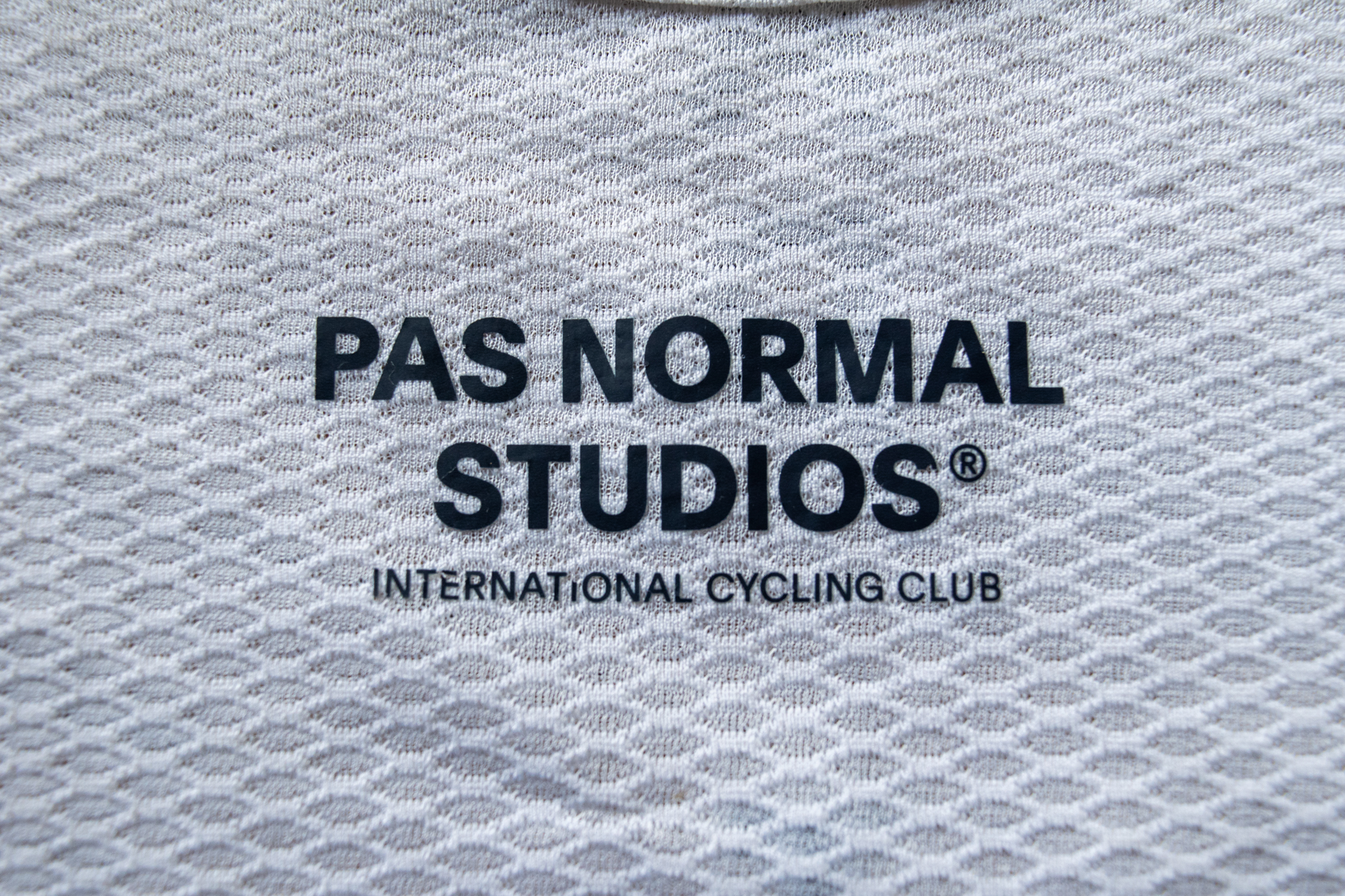

6. Pas Normal Sleeveless
Specifications
Reasons to buy
Reasons to avoid
✅ You wear lots of tighter, aero or race kit
✅ Like a really minimalistic base layer for summer or racing
❌ You prefer spending the least amount possible on your base layers
❌ You are particularly sensitive to label irritation
The simply named Pas Normal Sleeveless base layer is a stylish and minimalistic base layer constructed mostly of soft Polyester mesh.
It's super light and airy and Pas Normal give it a temperature use rating of 15/30C - 59/86F, so it should wick moisture well and regulate body temperature on really warm days. I've done a lot of riding in this base layer and like its comfort and shorter length. There isn't lots of it to tuck into shorts and it suits tighter, more aero jerseys very well.
It's available in seven colours and has a Pas Normal logo on the front and a large vertical 'Road to Nowhere' lettering down the back. It feels very unobtrusive to wear, almost like a second skin.
There is a newer and slightly more expensive Mechanism base layer from Pas Normal which I have also tested, but I prefer this one. It's more comfortable in my opinion and you can save the extra cash for something else.
Pas Normal also provides a 50% discount crash replacement policy in the event of an off as well.
How to choose
The best cycling base layers can be very specific in their design, but you can cover a wide range of temperatures with just a couple of well-chosen options. I have mentioned it above, but the differences between base layers are finer than perhaps something like waterproof jackets. I have pitted base layers against each other for a best-of-the-best list, looking at the finer details.
Start with a thin, lightweight option for warmer temperatures and a heavier-weight long-sleeve base layer for cold weather. By playing around with different clothing layering options you will learn what temperature ranges the base layers work best in and get a feel for what you prefer.
As a starting point note the temperature on each ride, what you are wearing and how you feel on the bike this is especially relevant in winter. You will start to create a memory bank and get better at knowing what to wear to be comfortable in a certain temperature range for the riding you are doing. It's surprising how many cyclists struggle with this, you will get to the point where you can look at the temperature and know exactly what to choose to stay comfortable.
What material is best for a cycling base layer?
Different materials play a big part in how a base layer will perform and the environments in which it will excel. These materials are generally split into two groups, man-made synthetic fabrics or natural materials.
Synthetic fabrics are often used for high-performance cycling base layers, suited to warm weather or indoor training, where sweat management and cooling effects are important. The stretch achieves a close fit to maximise wicking abilities to move sweat away from the body during a hard climb or during an intense Zwift session.
Natural materials such as merino wool don't wick or dry as quickly, however, they allow effective thermoregulation across a wide range of temperatures, making them extremely versatile. When wet, natural fabrics like merino still retain their insulating properties which makes them perfect for poor weather climates. Natural materials are also more resistant to unpleasant odours from riding; ideal if you are commuting to and from work or doing multi-day rides away from home.
What do the big brands say?
We asked clothing manufacturer Rapha for some advice on how to choose a base layer, after all, there is a lot of choice out there now.
The brand came back to us and said:
"When choosing a summer base layer, riders need to consider the conditions they’ll be riding in at every point of the day. Merino lightweight base layers are great for cooler starts and they can be really effective at improving the versatility of jerseys - many customers ride these throughout the British Summer."
For very hot days we’d recommend a lightweight sleeveless base layer which will wick sweat away from the body, which evaporates to provide a cooling effect. For multi-day events or ultra-distance races, merino is a great option as it’s incredibly good at managing odour as well as being quick-drying (if you’re lucky enough to get to wash it!).
"Last but not least, think about what colour jersey and bib straps you’re wearing, a base layer can be a great way of hiding bib straps or elevating your overall style on the bike."
How do you wear a cycling base layer
Contrary to what you might see in the pictures, the base layer goes under your bib straps. They are designed to be worn next to the skin, and so work best with as much skin contact as possible.
In order to show how long they are, and any features that may have been covered by the straps, I opted to photograph them worn over the bibs.
How should you wash and care for your base layers?
Caring for base layers is generally pretty easy. The majority of options on the market are marked as a 30-degree synthetic was. This means you can just wash your base layers with your regular cycling kit. Don't forget to close any zippers on jerseys or jackets to protect your kit in the wash.
Some merino wool items have more specific washing instructions to help you look after the material, some require wool-specific detergent to look after the item. Check your labels or ask the manufacturer if you're unsure.
Base layers also deal with a lot of sweat. And over time can get a bit stinky. Companies do make base layer and undergarment refresh products for synthetic products that aim to eliminate odours and boost breathability. Nikwax makes a 'Basewash' product if you are interested.
How should a cycling base layer fit?
The best cycling base layers should have a next-to-skin fit to offer maximum performance and should be the first layer next to your skin. Sitting close to the body will allow moisture to be wicked away effectively, and minimise any bunching which may cause discomfort when worn under other layers.
High-performance race-focussed base layers will feature flat-lock stitching, a wide collar to fit beneath skinsuits, and a pre-shaped cut optimised for an aggressive riding position. For longer or relaxed riding, opt for a casual cut, which relies on the material's stretch to provide a close, comfortable fit on and off the bike.
Which length sleeve is best for a base layer?
Most cycling base layers will come in a selection of sleeve options. Generally, short or sleeveless base layers are used for hot or changeable conditions as they will fit comfortably under a regular jersey and can be paired with the best arm warmers or a gilet if temperatures are changeable.
Long sleeves are the reserve of cold weather when you will be wearing other long sleeve layers all day. Pair with a long-sleeve-insulated jersey or jacket to keep your upper body toasty when the mercury drops.
What features make a cycling base layer better?
Some base layers will offer extra features to excel in specific conditions. Super thin mesh material side panels enhance breathability during max efforts in the hottest temperatures.
To be honest, you can get away with a lot in the summer months, winter is where you will pay if you get things wrong. Top tip, if you're doing a really long ride, carrying a spare base layer can make a lovely change if you stop at a cafe halfway way, change your base layer then and you will instantly feel more comfy.
Wind-proofing, water resistance, a high collar, or even a built-in balaclava hood are all important considerations if you are frequently riding headfirst into winter.
How we tested to find the best cycling base layers
I inspect every base layer in the guide out of the packet for construction and design features, record and log its weight, and photograph myself wearing each one.
I then put in the hard yards testing each one out on the bike. I experiment with different layers and cycling kit over a range of different temperatures and conditions, both in and outdoors (this is more specific to the winter base layers) I also test each base layer long-term to see how it washes and wears. I even rode in one for over 300 kilometres!
If you have any further questions on any of these base layers, feel free to shoot me an email and I'll do my best to answer.
The latest race content, interviews, features, reviews and expert buying guides, direct to your inbox!
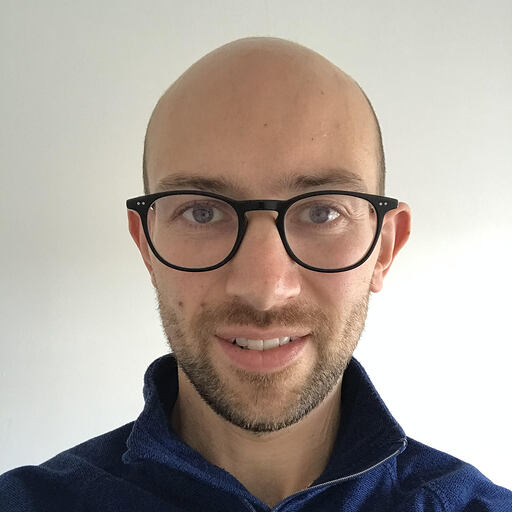
Tom joined the Cyclingnews team in late 2022 as a tech writer. Despite having a degree in English Literature he has spent his entire working life in the cycling industry in one form or another. He has over 10 years of experience as a qualified mechanic, with the last five years before joining Cyclingnews being spent running an independent workshop. This means he is just as happy tinkering away in the garage as he is out on the road bike, and he isn’t afraid to pull a bike apart or get hands-on with it when testing to really see what it’s made of.
He has ridden and raced bikes from an early age up to a national level on the road and track, and has ridden and competed in most disciplines. He has a keen eye for pro-team tech and enjoys spotting new or interesting components in the wild. During his time at Cyclingnews, Tom has already interviewed some of the sport's biggest names including Mathieu van der Poel, Tadej Pogačar and Alberto Contador. He's also covered various launches from brands such as Pinarello, Ridley, Specialized and more, tackled the Roubaix Challenge sportive aboard his own rim-brake Cannondale SuperSix Evo, tested over 20 aero helmets in the wind tunnel, and has created helpful in-depth buying advice relating to countless categories from torque wrenches to winter clothing.